32nd Annual Pre-Trib Study Group Conference
Sheraton Hotel, Irving, TX
December 4–6, 2023
Taking the Future Literally
The Importance of a Literal Interpretation of Ezekiel 40–48 to Biblical Hermeneutics
By Randall Price
Interpreting the Ezekiel’s prophecy has never been an easy task. The Talmudic rabbis struggled with the numerous textual difficulties and discrepancies from the Torah. Most decided that it was best to wait for the Prophet Elijah, at the final Redemption, to explain them (Babylonian Talmud, Menahoth 45a)! However, one named Rabbi Chanina ben Hezekiah accepted the challenge and sequestered in an upper chamber expended over 300 jars of oil in his lamps before successfully reconciling them. Had he not, we are told, the entire Book of Ezekiel might have been excluded from the Hebrew canon![1] Therefore, despite the difficulties presented by this book, and especially chapters 40-48, we must wrestle with it because with it we face the question of the literal interpretation of all the Bible. Indeed, these last nine chapters of Ezekiel serve as a test case for whether any Old Testament prophetic text related to Israel’s future restoration can be interpreted literally. Charles Lee Feinberg explains the importance of this when he writes:
Along with certain other key passages of the Old Testament, like Isaiah 7:14 and 52:13-53:12 and portions of Daniel, the concluding chapters of Ezekiel form a kind of continental divide in the area of Biblical interpretation. It is one of the areas where the literal interpretation of the Bible and the spiritualizing or allegorizing method diverge widely. Here amillennialists and premillennialists are poles apart. When thirty-nine chapters of Ezekiel can be treated seriously as well as literally, there is no valid reason a priori for treating this large division of the book in an entirely different manner.[2]
The most generally accepted interpretation of this prophecy by critical scholars is that it was understood by the post-exilic community as a spiritual ideal (never intended to realized literally) and fulfilled in their rebuilding of Zerubbabel’s Temple. Reform scholars and other non-futurists view these chapters as symbolic either of a spiritual entity such as the Church or the Church’s worship, Heaven, the eternal reign of God or the eternal state or the New Jerusalem. The hermeneutic used to accomplish this is the reading of the New Testament back into the Old Testament (especially the analogy of the Church to the Temple in Eph. 2:19-21 and the comparative description of the New Jerusalem in Rev. 21:1-22:5).[3] In this view, the New Testament is new (superior) revelation that reinterprets the old revelation to reveal its hidden message for the Church (cf. the concept of “better” in Hebrews understanding not simply that the fulfillment in Christ is “better,” i.e., superior to the promises concerning Him, but that this demonstrated a fulfillment theology showing the proper interpretation of the Old Testament types (especially concerning Israel), as subsumed in Christ the antitype.)
The Spiritual Vision Model Influenced a Non- Literal Interpretation
In the Spiritual Vision Model, heaven is seen as the place where believers in Christ are destined to live forever. It is a non-earthly spiritual place where believers will exist as spiritual beings engaging in spiritual activities. It is a realm of spirit and not of matter. This belief that the final dwelling place of Christians is in an ethereal heaven. Early church fathers, like Origen, a founder of the allegorical stream of hermeneutics, lived in Alexandria was influenced greatly by Plato and the Greek philosophers. Most of those who contributed to this model, like Augustine, were also influenced heavily by classical Greek philosophers. On the Jewish side, Philo Judaeus (Philo of Alexandria) followed Neo-Platonism to allegorize the Hebrew biblical heritage. This Greek philosophical bent toward the eternal and transcendent which superseded the changing material world produced a non-literal interpretation of Old Testament prophecy that has dominated Christianity for centuries. The hermeneutic developed from the Spiritual View Model prioritizes the New Testament (which it takes as a heavenly-oriented) and from this perspective re-reads and therefore reinterprets the Old Testament (which it takes as land-centered) from an assumed theological understanding that Jesus and the early Church transferred and transformed the fulfillment of restoration promises from National Israel as the old fleshly recipient to the Church, the new spiritual recipient.
An example of how this theological assumption based on the Spiritual Vision Model intrudes into literal historical research can be seen in George Athas (professor of Church History at Moore Theological College, Syndney, Australia) Bridging the Testaments: The History and Theology of God’s People in the Second Temple Period. After 388 pages of discussion on the political and religious events of the Second Temple period with the Jerusalem Temple as the most significant factor in Jewish history, the author moves to an excursus on “The Early Church and the Temple” in which he states:
The early church, however, saw Jesus’s vision being for a transformed people of God, transcending nation, land, and temple … Jesus demands the destruction of the old temple and the erection of a new one (John 2:19). This was not a call for the replication of the old system but a wholesale transformation … Jesus’s death was interpreted as a definitive sacrifice once for all time, obviating the need for ongoing sacrifice. The writer to the Hebrews, who wrote to Jewish Christians after the destruction of the temple in AD 70, argued against the need for a physical temple because of Jesus’s superior priesthood in accordance with the quasi-Platonic metaphysic of Jewish apocalyptic thinking … Jesus fulfilled the purpose of the old cult and rendered all subsequent earthly sacrifice defunct (Heb. 9:1-15) … This moved Jewish Christians away from the need for temple-based worship altogether by showing that Israel’s historic destiny had all along been a heavenly city without physical foundations (Heb. 11:10) – a heavenly Jerusalem (Heb. 12:22) reached by faith in Jesus. To turn back from this was tantamount to apostasy, akin to the rebellion of the Israelites who failed ultimately to reach the promised land (Heb. 3:16-4:11; 10:26-31) … it provided a theological mandate for graduating from Jerusalem-based temple worship.[4]
How can such an interpretation of early Jewish-Christianity incorporate and explain Paul, the foremost Jewish-Christian Apostle to the Greeks continuing to offer sacrifices in the Jerusalem Temple (Acts 21:21-26; 24:17-18) and to confess in his Roman trial that he had followed his ritual obligations to the Temple all of his life (Acts 25:8; 28:17; cf. 20:16)? Apparently, the Apostles Peter and John, who went to worship (including sacrifice) in the Temple (Acts 3:1-8) likewise had no understanding of the transformation and transferal that their Master had, according to this view, taught them.
Those who adopt the Spiritual Vision Model are predisposed to a spiritual interpretation of Old Testament (earthly) versus New Testament (heavenly) texts. They claim support for their view in the Book of Hebrews critique of Old Testament ceremonial ritual. Concerning this Jerry Hullinger notes:
The metaphorical view holds that the author is spiritualizing the cult in order to apply it to Christ, thus indicating the subjective benefits that accrue from His work. Therefore, everything spoken about loses its literal significance. In this view the literal priesthood is an analogy to speak of salvation, the heavenly sanctuary is the church, and the essence of sacrifice is not blood atonement but obedience. In this way of thinking Hebrews becomes an extended metaphor which is very much influenced (seemingly) by Platonic thought. In addition, it wreaks havoc with the literal correspondences between the sacrifices of the Old Testament and that of Christ.[5]
This spiritualizing principle is thought to have been the method employed by the New Testament writers in their use of the Old Testament and therefore the whole of kingdom preparation in the Old Testament must be understood as shadow giving way to substance. Karlberg argues in this vein when he writes: “In the eschatological age of the Spirit the kingdom of God is a spiritual reality unencumbered by the shadowy earthly forms (types) characteristic of the ancient theocracy.”[6] The dominance of the spiritual interpretation in the eastern and western churches and the denominations developed from (or in opposition to) them has made the literal interpretation of Dispensationalism appear as either extreme (US) or bizarre (UK). National Israel under the Old Covenant only existed as a failed experiment that allowed the spiritual remnant (the Church, the True Israel) to attain to the New Covenant. Since the legal and ritual systems under the Old Covenant were to yield to the spiritual grace system of the New, the idea of a literal fulfillment for the promises to National Israel had to be recast to symbolic or spiritual fulfillment for the Church. Ezekiel 40-48 as indicative of, if not a template for, the restoration of National Israel could only be understood as having apocalyptic fulfillment in the present as the idealized temple, spiritual fulfillment eternally in the Kingdom of God or the New Jerusalem or as a symbol in the present of the Church.
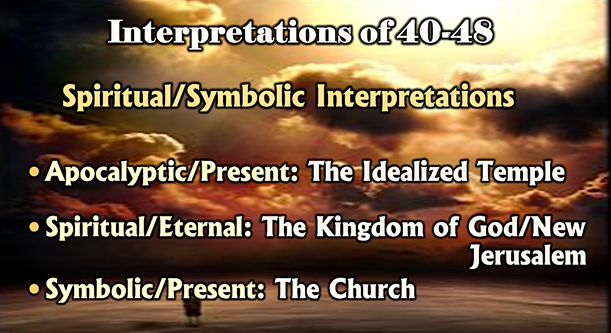
Although there are similarities with Ezekiel’s Temple and spiritual realities, for example in the description of the New Jerusalem as being built on a high mountain, having high walls and the abiding Presence of God there are significant differences (the description of the New Jerusalem far surpasses that of Ezekiel’s Temple) and similar abodes of God’s glory in the eschaton and eternal state would expect resemblances. However, if literal interpretation is rejected, in deference to the Spiritual Vision Model, then not only is there no portion of Scripture which supplies the instructions for the construction of the future Temple and its service and the way has been opened for the spiritualization of all of the restoration prophecies to Israel.
The New Creation Model Promotes Literal Interpretation
By contrast, the New Creation Model finds the fulfillment of the divine ideal of Eden in the new heavens and new earth of the millennium and eternal state.[7] This is supported by the Prophets’ statements of the New Covenant that declare God’s promises to national Israel are permanent and inviolable (Jer. 31:35-37; 33:20-26; cf. fulfillment in Isa. 61:4-7; 65:17-25; 66:18-23; Ezek. 37:25-28). Attached to the first and last statements of the New Covenant (Jer. 31:27-34; 33:1-19) these legal affirmations serve as the strongest sworn statements of the divine promise guaranteeing their eventual fulfillment for Israel. Thus, as the rules of nature exist and stand forever, so the sons of Israel will be God’s chosen people forever. As the correct orders of creation exist in His presence, so will the seed, that is descendants of Israel; both are permanent. This vindicates divine justice against the indictment of the nations that God could not fulfill His promises to His People (Ezek. 36:20). God had to act in judgment due to His attribute of justice (Amos 3:2) and to also act in mercy because of His attributes of immutability and love (Rom. 11:28-29, 31).[8]
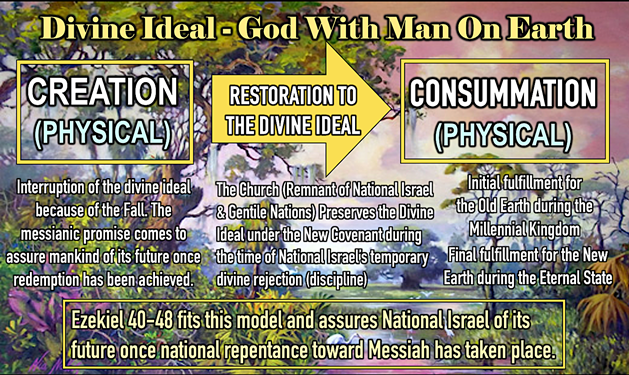
The only way this undeniable national promise can be construed to not find fulfillment with national Israel is by a larger theological reinterpretation that transforms everything national (land-based) to spiritual (heavenly). On this basis, fulfillment is only with the Church as the intended recipient (the True Israel) or by inheriting the spiritual blessings originally given to national Israel as their spiritual replacement.[9] Advocates of this method of interpretation must view Ezekiel 40-48 within their schema and therefore argue that it precludes a literal fulfillment in history with National Israel.
Does Lack of Past Fulfillment Argue Against Literal Interpretation?
However, before considering arguments for a literal interpretation, the fact that history reveals Ezekiel’s Temple was never built by the post-exilic community has been used as an argument against taking the text as a literal plan to rebuild. Department Chair and Senior Professor of Old Testament Studies at Dallas Seminary Robert Chisholm, Jr. argues that normal literal interpretation cannot be supported here because the historical failure to rebuild demands a reinterpretation . He writes:
Ezekiel’s vision of a new temple and a restored nation was not fulfilled in the postexilic period. How then should we expect the vision to be fulfilled? Scholars have answered this question in a variety of ways. On one end of the interpretive spectrum are those who see the vision as purely symbolic and as fulfilled in the New Testament church. On the opposite end are the hyper-literalists, who contend that the vision will be fulfilled exactly as described during the millennial age. In attempting to answer the question, one must first recognize that Ezekiel’s vision is contextualized for his sixth-century B.C. audience. He describes the reconciliation of God and his people in terms that would be meaningful to this audience. They would naturally conceive of such reconciliation as involving the rebuilding of the temple, the reinstitution of the sacrificial system, the renewal of the Davidic dynasty, and the return and reunification of the twelve exiled tribes. Since the fulfillment of the vision transcends these culturally conditioned boundaries, we should probably view it as idealized to some extent and look for an essential, rather than an exact fulfillment of many of its features.[10]
First, there is no evidence in the post-exilic prophets that the post-exilic community upon their return to Jerusalem expected to rebuild the Temple according to Ezekiel’s plan. Why in exhorting the community to rebuild the Temple did they not repeat Ezekiel’s instructions since they were, in fact, God’s instructions? Rather, the post-exilic prophets indicate that rebuilding the Temple was not a priority,[11] and it is clear that when the community finally rebuilt they only followed the plan of First Temple. Even then, they were unable to duplicate that plan and its inferior form caused grief to those who had seen the original structure (Ezra 3:12). Therefore, there is nothing to suggest that Ezekiel’s design influenced the construction of the Second Temple under the priest Zerubbabel and Jeshua and their fellow priests and Levites (Ezra 3:2, 8; 5:2; Hag. 1:1, 14; 2:4; Zech. 4:9).
Second, there is the witness of the Jewish People during the Second Temple period that they interpreted the building of Ezekiel’s Temple plan as literal and reserved for the time of National Israel’s complete restoration to the Land and the Lord, something required in Ezekiel (36:22-37:28) but never experienced and still anticipated by the post-exilic prophets (e.g., Hag. 2:5-9; Zech. 8:3-23). The Second Temple Jewish community that provides us with this evidence is the Qumran Community that settled in the Judean desert near the Dead Sea ca. 150 BC in an earlier Iron Age settlement that had been abandoned in the Hellenistic period. Those leading this settlement are believed to have been Zadokite priests who were replaced in their duties in the Jerusalem Temple by Hasmonean priests after the Maccabean Revolt (167-164 BC). When their documents were discovered in the late 1940’s-50’s, among them was a document that been called the Temple Scroll (11Q19). Based on its date it preceded the Qumran Community and therefore may have been the product of the last generation of post-exilic Jews under the Seleucid dynasty. Possibly authored by a Zadokite priest, the Temple Scroll gives a plan for a future rebuilt Temple whose design was clearly influenced by that in Ezekiel 40-48.
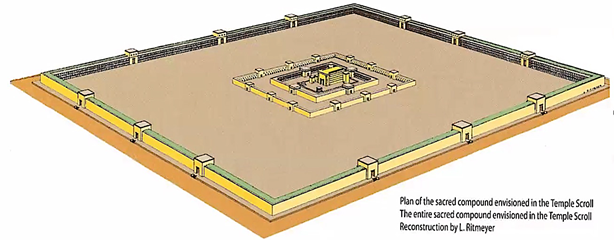
The time in the future when this Temple is expected to be built is stated in the Temple Scroll:
And I will consecrate My [T]emple by My Glory (Shekinah), (the Temple) on which I will settle / My Glory, until the day of blessing (= the End of Days) on which I will create My Temple / and establish it for Myself for all time, according to the covenant which I have made with Jacob at Bethel.” 11QTemple 29:8-10
Notice in this passage that this Temple is to be built in the eschatological future (“Day of Blessing”) when the Shekinah Glory will return to Jerusalem (cf. Ezek. 43:1-7) and that this is expected to be the Temple that will stand for “all time.” Another passage expected that the Ark of the Covenant would be recovered and installed within this Temple (11Q19 7:10-12). In addition, Yigael Yadin, who did the initial research and publication of the Temple Scroll, concluded that it was a literal Temple for the eschatological age:
The author [of the Temple Scroll] was definitely writing about the earthly man-made Temple that God commanded the Israelites to construct in the Promised Land. It was on this structure that God would settle his glory until the day of the New Creation when God himself would "create my Temple … for all times" in accordance with his covenant "with Jacob at Bethel.[12]
There are other Dead Sea Scroll texts such as The New Jerusalem (4Q554; 55Q15) and apocalyptic works (included in the Dead Sea Scrolls library) such as Jubilees and 1 Enoch that also reveal a dependance on Ezekiel’s Temple plan but the Temple Scroll is sufficient to show that this Jewish sect understood a literal and eschatological interpretation of Ezekiel 40-48.
Further evidence that the post-exilic community understood a literal interpretation of Ezekiel 40-48 can be seen from the Samaritan temple built during the Persian period (ca. 450 BC).[13] The Samaritan ruler Sanballat, after being denied by the post-exilic leaders a part in building the Judean Temple (Ezra 4:1-5; Neh. 2:10; 4:1) constructed a rival temple on Mt. Gerazim. Based on the archaeological witness it has been thought that some of Ezekiel’s design features may have been employed in combination with those of the First Temple.[14] George Athas explains:
The sacred complex at the top measured approximately 96 x 98 meters and was surrounded by a dry-stone wall. Chambered gates in the northern, eastern, and southern walls led into an open courtyard with an altar at its center. The altar and courtyard lay directly before the sanctuary, which was approximately 40 meters by 20 meters wide, and stood in the central western part of the complex. The sanctuary was entered on its east side, with the Holy of Holies at its western end. While the configuration resembled other tripartite temple structures in the ancient Near East, it bore particular resemblance to both the Jerusalem Temple in Ezekiel’s day (Ezek. 8-11) and his idealized temple (Ezek. 40-48). This suggests that it was modeled upon Jerusalem’s temple and touted as its successor.[15]
If Sanballat indeed tried to incorporate some of Ezekiel’s design, it tells us that Ezekiel’s plan was clearly known to the post-exilic community.[16] What is pertinent to our discussion is that based on this detail from the archaeological excavation of the Samaritan temple it can be understood that Ezekiel’s Temple design was accepted literally.
Literal Interpretation of Ezekiel 40-48
Biblical higher critics accept that Ezekiel had a literal structure in mind, but only with respect to a past temple (Solomonic, viewed as an ideal temple) or of a present temple in its former and latter constructions (the Zerubbabel or Herodian Second Temple). They argue Ezekiel’s grandiose description was hyperbolic with the intent of encouraging the post-exilic (not pre-exilic) community. Despite viewing Ezekiel’s Temple as an historical structure, their concept of an idealized or exaggerated design denies the literal understanding of the text’s description which cannot be successfully harmonized with any historical Temple (e.g., greater dimensions, elevated position and location in the Land, differences in ritual practice and priesthood, absence of sanctuary furniture, tribal arrangements in the Land). The only literal interpretation that respects the text in context is the future (eschatological) interpretation that understands fulfillment historically in the coming Millennial Age. This has been the historical interpretation of Orthodox (rabbinic) Judaism and argues that their predecessors in the post-exilic Jewish community realized fulfillment awaited the time of future restoration when all of the conditions of global spiritual and physical restoration (including the subjugation of the Gentile nations) had occurred.
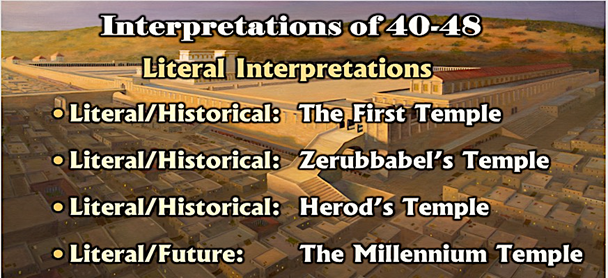
Let us therefore consider seven arguments from Ezekiel 40-48 that will answer the critics objections and support the literal eschatological interpretation of this section of the prophetic word.
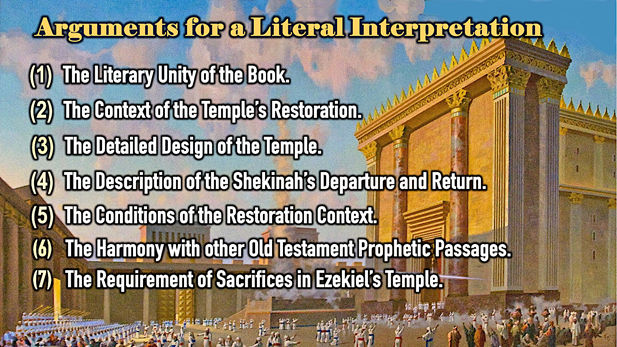
1) The Literary Unity of the Book Requires a Literal Interpretation Be Understood Throughout
Chapters 40-48 form an inseparable literary conclusion to the book. Although these chapters constitute a new vision in the prophecy, they are linked with chapters 1-39 in repeating earlier themes in a more detailed fashion. This linkage may be seen in the fact that the beginnings of chapters 1 and 40 share several similar features. For example, Ezekiel’s vision of the presence of God in Babylon (Ezekiel 1:1; compare 8:1) finds it complement and completion in the vision in the Land of Israel (Ezekiel 40:2). In like manner, the problem created by the departure of God’s Presence in chapters 8-11 finds its resolution with its return in this section (see Ezekiel 43:1-7).[17] In fact, the concern for the Presence of God could be argued as the uniting theme of the entire text of Ezekiel."[18] Without chapters 40-48 there is no answer to the outcome of Israel, no resolution to their history of sacred scandal, and no grand finalé to the divine drama centered from Sinai on the Chosen Nation.
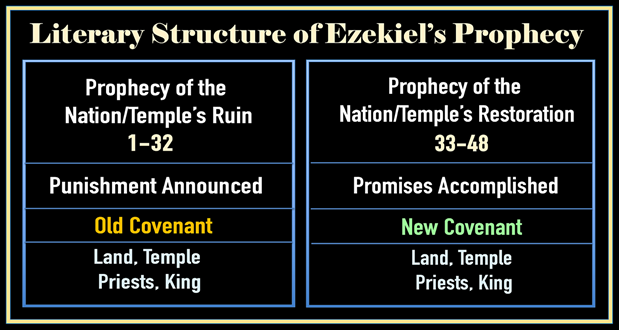
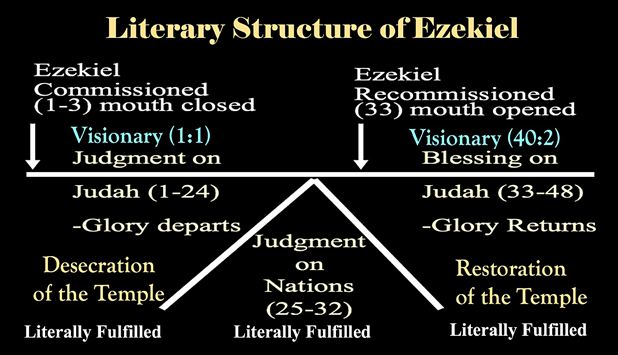
Ezekiel’s prophecy of the future Temple is the means to restoring the Presence of God to Israel. Its focus in the book falls into three divisions: (1) Prophecies of the Temple’s desecration and destruction (Ezekiel 4:1-24:27), (2) Prophecies of Israel’s return and restoration (Ezekiel 33:1-39:29), and (3) Prophecies of the Temple’s rebuilding and ritual (40:1-48:35). Since it was the physical First Temple whose desecration and destruction was discussed in the first section of the book, the last section’s discussion of a Temple’s restoration would also expect a structure of the same kind. In view of the exilic understanding of a return from captivity necessitating a rebuilding of the Temple (Daniel 9:20; 2 Chronicles 36:22-23; Ezra 1:2-11; Haggai 1:2-2:9; Zechariah 1:16; 6:12-15; 8:3), would Ezekiel (or God) have attempted to comfort his people’s loss with anything other than the literal restoration of a physical Temple to which the Divine Presence would return?
If it is countered that chapters 40-48 are a spiritual vision and therefore not meant to be a literal reality, again the literary structure of the book argues against this possibility. In chapters 8-11 all interpreters agree that the literal Solomonic Temple in Jerusalem is in view. Ezekiel’s description of its desecration is the basis for his explanation to the exilic community of why God would have to remove His Presence and destroy its structure. However, it must be remembered that Ezekiel was not physically present in Jerusalem when he reported these things, but in Babylon with the Judean exiles. Rather it was “in the visions of God” that he was spiritually transported to Jerusalem (Ezekiel 8:3). Everything he mentions there concerning the Temple, its “inner court” (8:3), “porch” (8:16), “altar” (8:16), “threshold” (9:3), and “East gate” (10:19), were all seen in a vision. Yet, they are considered to have been a vision of the literal Temple. Why then, when in a vision of the Temple (Ezekiel 40:2) in chapters 40-48 he mentions the exact same places: “inner court” (40:27), “porch” (40:48), “altar” (43:18), and “East gate” (43:3), are they now only spiritual symbols? Moreover, Moses saw the plan for the Tabernacle in a vision (Ex. 25:8, 40) as did David for the plans of the First Temple communicated to his son Solomon (1 Chr. 28:11-19), and no one contests that these “visions” were built literally in history. It is inconsistent to accept these “visions” as fulfilled literally but to argue that Ezekiel’s “vision” must be interpreted symbolically.
To summarize this point based on the literary unity of the book: If the visionary description of the First Temple and the prediction of its destruction is deemed historically accurate and, as all interpreters acknowledge, was literally fulfilled literally (Ezek. 24:2; 33:21; cf. 2 Kgs. 25:9; 2 Chr. 36:19; Neh. 2:17; Jer. 39:8; 44:6), why would not the same details and the prediction of its rebuilding not also expect literal fulfillment? If Judah and Jerusalem’s destruction and exile was literal, though described in a vision, why should not it restoration from exile and rebuilding (Ezek. 36-37; 40-48) not be understood as literal.
2) The Context of the Temple’s Restoration Requires a Literal Interpretation
These chapters open with a contextual note concerning the specific date of Ezekiel’s vision on “the tenth of the month [of Tishri]” (Ezekiel 40:1). The Jewish Sages saw this as already setting an eschatological context since the tenth of Tishri is reckoned as a Jubilee year [Hebrew, yovel], and the date of Ezekiel’s vision was determined to be the first Day of Atonement [Hebrew, Yom Kippur] of the Jubilee year. Together, this date prefigured Israel’s Day of Redemption in both its physical (Land) and spiritual aspects as Rabbi Joseph Breuer notes: “On that day, which summoned the subjugated and estranged among God’s people to accept freedom and called upon all the sons of Israel to return to their God, on that day it was given to the Prophet to behold a vision of the rebuilt, eternal Sanctuary of the future and to receive the basic instructions for the establishment of the State of God that would endure forever.”[19] Therefore, from the very first verse the Rabbis considered the context both literal and eschatological. If, as the New Creation Model affirms, the goal of the Creation is a renewal of man and earth so the two fulfill the co-regency of the Creation Mandate within a Theocratic Kingdom (see Rom. 8:19-24 and on the New Earth in the Eternal Kingdom (Eternal State). Since this goal requires God dwelling with His Creation (Psa. 68:16; 132:13-14; Ezek. 37:26-28; 43:7, 9; 48:35; Zech. 2:10; 8:3; Lk. 13:28-29; 22:29; Rev. 5:10; 11:15; 20:6; 21:3) an earthly Sanctuary is required. However, the eternal dwelling of God with man on earth is reserved for the future eschaton. Therefore, Ezekiel’s Temple can only have its construction within the eschatological context of the present earth during the Millennial Kingdom when the Messiah returns to reign for the thousand years (Matt. 25:31; Rev. 20:4, 6).
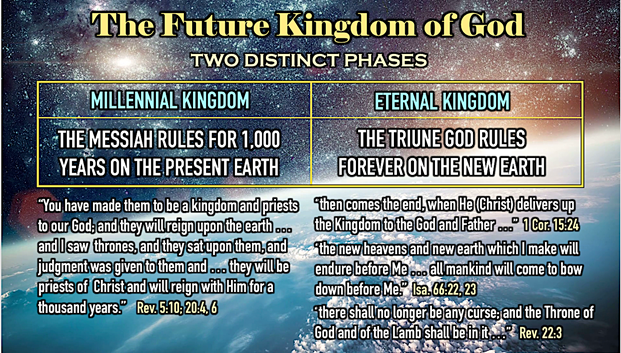
Daniel had also predicted that the Temple would be reconsecrated in the future as the climatic fulfillment of six eschatological restoration goals (Dan. 9:24). The reconsecration of Ezekiel’s Temple by the restored Presence of God appears as the climatic event in the restoration context of Ezekiel 37:25-28, which serves as an introductory summary of chapters 40-48: “And they shall live on the Land that I gave to Jacob [Israel] My servant, in which your fathers lived; and they will live on it, they and their sons’ sons, forever; and David My servant shall be their prince forever. And I will make a covenant of peace with them; it will be an everlasting covenant with them. And I will place them and multiply them, and I will set My Sanctuary [Hebrew, Miqdash] in their midst forever. My dwelling place [Hebrew, Mishkan] also will be over them; and I will be their God, and they will be My people. And the nations will know that I am the Lord who sanctifies Israel, when My Sanctuary [Hebrew, Miqdash] is in their midst forever.”
These verses reveal that the future restoration of the Nation will be in the same place (Israel) and in the same form (a Temple) as the past. The geographical context for this prophecy is “the Land that I gave to Jacob My servant, in which your fathers lived….” The mention of Jacob, who name was changed to “Israel” (verse 25), along with the historical habitation of “the fathers,” distinguishes this place as unquestionably the Land of Israel. Notice, too, the covenant made between God and Israel is “a covenant of peace …” (verse 26). No such covenant of security and well-being (the idea of the Hebrew shalom translated here as “peace”) was ever made with God during any time in Israel’s past, nor will it be made during the Tribulation period (the covenant of Daniel 9:27 is not stated to be a “peace covenant”). According to Ezekiel 34:25-29 this covenant is Land-centered, completely eliminating harmful animals, guaranteeing security from any foreign invasion, and bringing unparalleled agricultural renewal accompanied by divinely-sent seasonal rains (compare Zechariah 14:17). In addition, this covenant, unlike those of the past, is said to be “eternal.” This restoration of ethnic Israel, an event predicted by Paul (Rom. 11:25–32), can only be eschatological since history reveals that the northern tribes never returned to the land and disappeared as they were assimilated into the surrounding culture. Ezekiel’s vision of national restoration will be fulfilled only through the Jewish people, who are descended from Judah, Benjamin, and Levi (Ezek. 37:15–28; cf. Isa. 11:13–14; Jer. 31:31–37). This the first phase of restoring Creation to the Divine Ideal (redemption of man/world to reflect God’s image).
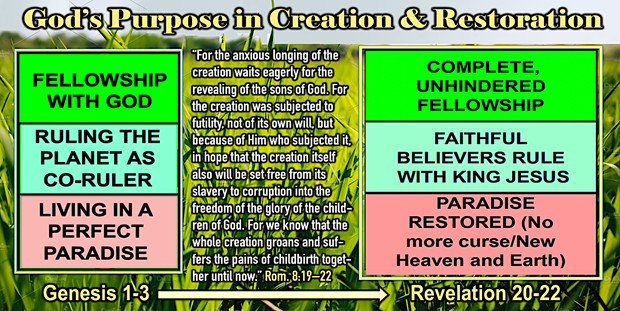
Ezekiel’s Temple Can Only be an Eschatological Temple
The Temple is here described in terms that can only be realized in the future. First, the Temple is called a mishkan, the Hebrew word used formerly for the Tabernacle and said to be “over them” (Hebrew, ‘lyhm).[20] This pictures God’s “sheltering Presence” as once the pitched Tabernacle in the wilderness protected the Israelite tribes. One of the false hopes of the past was in the inviolability of the Temple and its ability to preserve the disobedient Nation simply because it existed. In the future, however, the Nation will not sin and the Temple, with the Shekinah, will serve as the source of the Nation’s, and the world’s, prosperity and peace. The Temple is also called miqdash “Sanctuary,” emphasizing its holiness, and is said to be, like the covenant and the restoration of God’s Presence, “eternal” (verses 26, 28). Again, such a Temple could only find its fulfillment in the Millennial Kingdom where the protective “Glory-cloud” of God will return to fulfill this concept of the Temple (see Isaiah 4:5-6). This Temple, presented as part of the eternal covenant, in is that which is expanded upon in greater detail in the prophecy of chapters 40--48.[21]
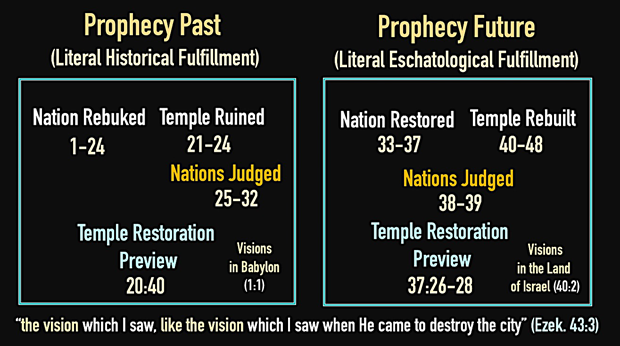
As Professor Moshe Greenberg of the Hebrew University of Jerusalem explains:
The fivefold repetition of “forever” stresses the irreversibility of the new dispensation. Unlike God’s past experiment with Israel, the future restoration will have a guarantee of success; its capstone will be God’s sanctifying presence dwelling forever in the sanctuary admidst his people. The vision of the restored Temple (and God’s return to it) in chapters 40-48 follows as a proleptic [anticipatory] corroboration of these promises.[22]
Based on the nature of the promised restoration as revealed in Ezekiel 33-37, the returning exiles surely must have recognized that the nature of Ezekiel’s future Temple in chapters 40-48 was also eschatological. Therefore, those who rebuilt the Temple after the Babylonian Captivity did not attempt to implement its architectural design or priestly instructions. Their assessment of the kind of restoration they were experiencing had to be weighed against several factors: (1) The larger proportion of the Jewish population had chosen to remain in Persia and Egypt, (2) Only a paltry 49,897 Jews had returned to Judah (Ezra 2:64-65), and (3) the low level of spiritual life evident among the resident Jewish in the Land (Ezra 5:16; 9:1-4; Haggai 1:2-6). These realities must have indicated that their return and rebuilding was not the fulfillment of the final restoration described in Ezekiel. This was probably most apparent when the foundation of Zerubbabel’s Temple had been laid and the older people wept because it did not measure up to Solomon’s Temple (Ezra 3:12-13; Haggai 2:3), much less that envisioned by Ezekiel. Therefore, it must have been understood that Ezekiel’s Temple awaited the more complete promise of restoration which included the coming of the Messiah (Ezekiel 34:11-31), a full regathering of the entire Jewish Remnant (Ezekiel 36:24, 28), and a national spiritual regeneration (Ezekiel 36:25-27; 37:1-14). If Ezekiel’s readers were interpreting his restoration program for the eschatological age, then they would understand the interruption of Ezekiel’s “Gog and Magog” battle (Ezekiel 38-39) between the discussions of the Temple in chapters 37:25-28 and 40-48. This literary placement not only helped the readers understand an eschatological context for the Temple prophecy, but added the assurance that, unlike the foreign invasions of the past, even this greatest of foreign invasions in the future could not disturb God’s plans for the final Temple.
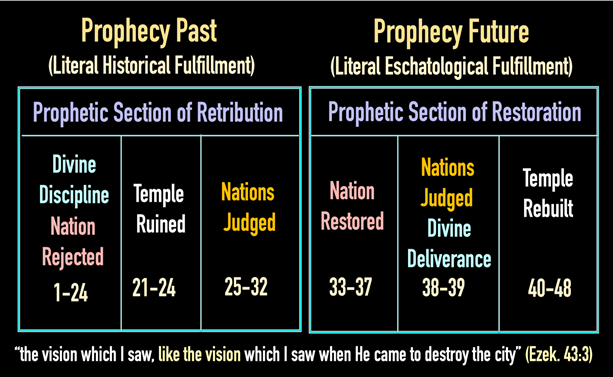
In Ezekiel’s literary scheme this is demonstrated with sections of Gentile judgment in the past (chs. 25-32) and future (chs. 38-39), the Nation rebuked (1-24) and restored (33-37), and the Temple ruined (chs. 21-24) and rebuilt (chs. 40-48). This literary structure displays the eschatological motif of desecration and restoration so common to the Prophets. In Ezekiel both sections are visionary but require that just as the sections of rebuke and ruin were fulfilled historically and literally, so must the sections of restoration and rebuilding.
Theologically, we understand with the New Creation Model that in the Millennial Kingdom Ezekiel’s Temple fulfills the divine ideal that was created in the Garden of Eden with man as a sinless co-regent (Gen.1:26-28) and priest (Gen. 2:15) with a localization of the Divine Presence (Gen. 3:8) in the western part of the Garden, which appears to have constituted an earthly sanctuary.
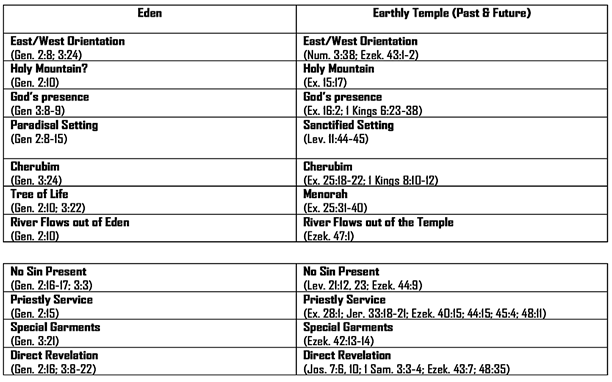
3) The Description of the Shekinah’s Departure and Return Requires a Literal Interpretation
In Ezekiel’s prophecy of the desecration and destruction of the First Temple he gives a detailed picture of the progressive withdrawal of the Shekinah and its abandonment of the Sanctuary. While this may be thought to have been a symbolic and spiritual act, the description of the arrival of the Shekinah in 1 Kings 8:10-11 and 2 Chronicles 7:1-3 indicates that it was quite literal and visible. Therefore, when Ezekiel 43:1-7 details the return of the Shekinah to the rebuilt Temple, it cannot be understood in terms other than in the earlier context of Ezekiel and in harmony with the texts in the historical books. Moreover, this cannot be said to have been fulfilled in any other Temple, for nowhere in Scripture (nor in extra-biblical Jewish literature) is it stated that the Divine Presence filled the Second Temple as it did the Tabernacle (Exodus 40:34-35) and the First Temple (1 Kings 8:10-11; 2 Chronicles 5:13-14; 7:13). Rather, Jewish sources made a point of its absence (see Tosefta Yom Tov) and relegated such a hope to the eschatological period known as “the period of restoration of all things” (Acts 3:21). Considering the text of this prophecy in Ezekiel we read: “Then he [the angelic guide of 40:4] led me to the gate facing toward the east [Eastern Gate]; and behold, the Glory of the God of Israel was coming from the way of the east. And His voice was like the sound of many waters; and the earth shone with His glory … And the Glory of the Lord came into the house [Temple] by the way of the east. And the Spirit lifted me up and brought me into the inner court; and behold the Glory of the Lord filled the house. Then I heard one [God] speaking to me from the house, while a man [the angelic guide] was standing beside me. And He said to me, “Son of man, this is the place of My throne and the place of the soles of My feet, where I will dwell among the sons of Israel forever. And the sons of Israel will not again defile My holy Name …” (Ezekiel 43:1-7).
Note here that Ezekiel presents the return of the Shekinah in a precise reversal of its departure detailed in chapters 9-11: Departure: Holy of Holies to Inner Court to Eastern Gate to east; Return: east to Eastern Gate to Inner Court to Holy of Holies. The order intentionally matches so that Israel is able to realize the fulfillment of complete restoration, which heretofore lacked the decisive final act of the restoration of the Divine Presence. Note, too, that this return fulfills the Divine ideal of the Creator dwelling with His creation first shown at Eden and then at Mount Sinai. In this respect note the elements of God’s approaching Presence in the Garden of Eden (compare Genesis 2:8; 3:8) are repeated: an eastward orientation (verses 2, 4) and the sound of God’s voice verse 2), and the reference to “the Glory of the God of Israel” (verse 2) reminding the reader of His original return (the Tabernacle in Sinai) and of His prophetic promise to return His Glory (in the same way) to the Final Temple (Haggai 2:5, 7, 9). The last aspect of this description that confirms this is the future Messianic Age is that the “sons of Israel” will be not be able to again defile the Temple as in the past (verse 7). This will be because they have been constitutionally changed to prevent this possibility (Ezekiel 36:25-27; 37:14, 23). In summary, the literal Presence of God left a literal Temple (Ezek. 9-11). Since it was promised to return in exactly the same way to exactly the same place (Ezek. 43:1-7) this future fulfillment must be in a literally rebuilt Temple.
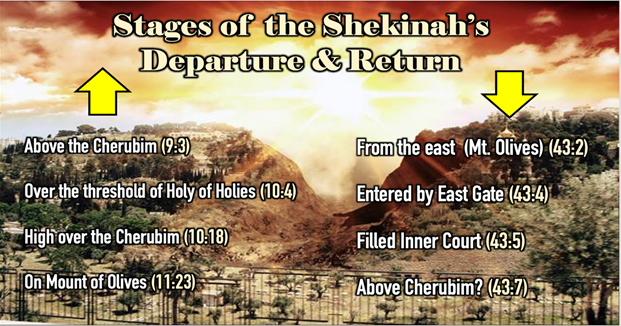
While the support for the Millennial Temple does not depend on this prophecy alone, it is the major text preserving the details for implementing its construction in the Millennial Kingdom.
4) The Conditions of the Restoration Context Requires a Literal Interpretation
In Ezekiel 43:18 the Prophet states the time for the rebuilding of the Temple and the installation of its ritual elements, such as the Brazen Altar. The text reads: “Son of man, thus says the Lord God, ‘These are the altar’s statutes on the day (בְּיוֹם הֵעָשׂוֹתוֹ) it is built …” This “day” (time) is understood in the context of this text (as well as other restoration texts) by specified conditions:
- Topographical dimensions - high mountain (Ezek. 40:2; cf. 20:40-44; Zech. 14:10)
- Israel’s national repentance (Ezek. 43:10-11; cf. 36:31-32)
- Israel national regathering and regeneration (Ezek. 43:7b; cf. 36:21-31; 37:4-14)
- Restoration of Zadokite priesthood (Ezek. 43:19; cf. 44:15-16)
These conditions require an eschatological fulfillment with National Israel within Israel’s covenant Land. However, additional conditions in the larger restoration context of Ezekiel’s prophetic section further support the time of the fulfillment of Ezekiel’s recorded vision.
The Description of the Restoration Land
The consecration of Ezekiel’s Temple by the restored Presence of God appears as the climatic event in the restoration context of Ezekiel 37:25-28. It serves as an introductory summary of chapters 40-48. These verses reveal that the future restoration of the Nation will be in the same place (Israel) and in the same form (a Temple) as the past. The geographical context for this prophecy is “the Land that I gave to Jacob My servant, in which your fathers lived….” The mention of Jacob, who name was changed to “Israel” (verse 25), along with the historical habitation of “the fathers,” distinguishes this place as unquestionably the Land of Israel. Notice, too, the covenant made between God and Israel is “a covenant of peace …” (verse 26). This covenant is Land-centered, completely eliminating harmful animals, guaranteeing security from any foreign invasion, and bringing unparalleled agricultural renewal accompanied by divinely sent seasonal rains (Zech. 14:17). No such covenant of security for the Land was made with God and Israel during any time in the Nation’s past nor will it be made during the Tribulation period. Moreover, this covenant is stated to be “eternal.” The only possible time for a literal fulfillment is the Millennial Kingdom, a time in which Israel as a Nation is restored to its Land in peace.
The Description of the Restoration Temple
The Temple is described in terms that can only be realized in the future. It is called a mishkan; the Hebrew word used formerly for the Tabernacle and said to be “over them.” This pictures God’s “sheltering Presence” as once the pitched Tabernacle in the wilderness protected the Israelite tribes. One of the false hopes of the past was in the inviolability of the Temple and its ability to preserve the disobedient Nation simply because it existed. In the future the Nation will obey and the Temple, with the Shekinah, will serve as the source of the Nation’s, and the world’s, prosperity and peace. The Temple is also called miqdash “Sanctuary,” emphasizing its holiness, and is said to be, like the covenant and the restoration of God’s Presence, “eternal” (vss. 26, 28). Such a Temple could only find its fulfillment in the Millennial Kingdom where the protective “Glory-cloud” of God will return to fulfill this concept of the Temple (cf. Isaiah 4:5-6).
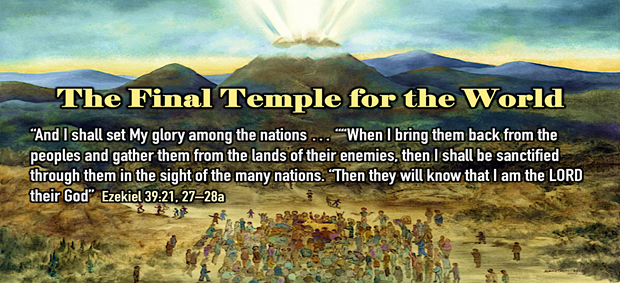
Another unique element of this future Temple is found in Ezekiel 47:1-12 where a river of water flows from under the threshold of the Temple from the right side south of the altar (vs. 1), then descends eastward producing fruit trees along its banks, and finally to the Arabah where it will merge into the Dead Sea, causing its waters to become fresh and sport many kinds of fish but leaving its swamps and marches salty (vss. 2-12).
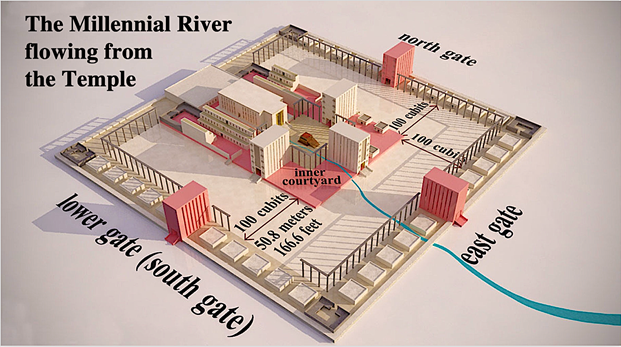
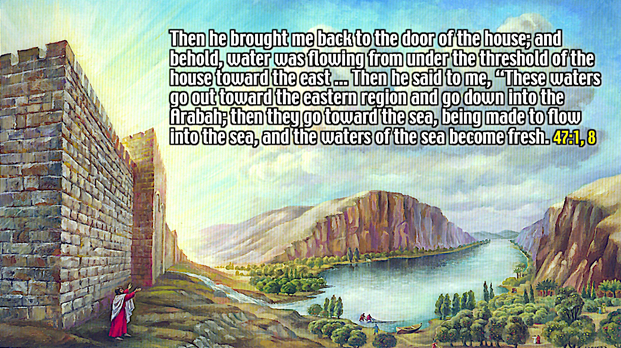
Critics argue that this imaginative account is evidence that the whole of Ezekiel 40-48 is to not be taken literally. Against the critics on this point Merrill F. Unger has replied:
Keil insists that the marvelous river issuing from the temple cannot be regarded "as an earthly river," but can only be interpreted figuratively, and from this false premise concludes that therefore neither the temple, nor the ritual, nor the division of the land can be construed as literal. That the river is a literal stream, and that the temple mount will be exalted on a high eminence as the result of vast physical changes in the topography of Palestine is emphatically stated by others besides Ezekiel. Isaiah (35:1-10; 40:3-5) and particularly Zechariah are emphatic on this point (Zech. 14:4, 5). Only unbelief and blatant infidelity can wrestle with these Scriptures as presenting geographical impossibilities. God can do all that is necessary to revamp and remake the land of Palestine to make it a suitable scene for all the glorious events of the Kingdom Age.[23]
The Description of the Restoration Tribal Allotments
The twelve tribes of Israel, having been regathered, re-identified, reunited, and restored to the Lord and to the Land will be re-distributed by tribes within the boundaries of the Land. The seven northern tribes will be separated from the five southern tribes by the holy portion upon the Millennial mountain with its elevated city of Jerusalem and Temple. The northern tribes are allotted their inheritances (48:1-7). Moving from the north to south these include Dan (verse 1), Asher (verse 2), Naphtali (verse 3), Manasseh (verse 4), Ephraim (verse 5), Reuben (verse 6), and Judah (verse 7). The central portion of the Land (48:8-22) contains the Millennial mountain, with the precise location now revealed as south of the borders of the tribe of Judah (verse 8).
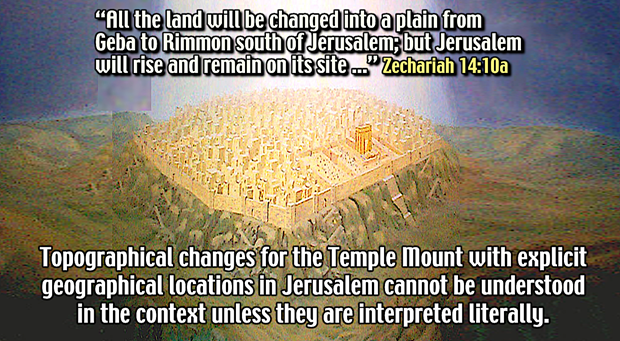
In the middle of the northern division of the holy portion on the mountain is the Millennial Temple (verses 10, 21). This holy portion (verses 12-15) also contains the Millennial Jerusalem in the southern division that will be laid out as a square of 4,500 cubits (7,875 feet) covering an area of 2.2 square miles (verse 16). The Millennial Jerusalem will have lands around it 250 cubits wide (437.5 feet) wide and on either side land measuring 10,000 cubits (3.3 miles) long and 5,000 cubits (1.65 miles) wide (verse 18a). This land is under the control of workers (who live in Jerusalem but who come from all the tribes) and is designated for agricultural purposes in order to feed the working population (verses 18-19). This mention of physical consumption reminds us (along with those in 36:9-11, 29-30, 34-36; 47:12) that the renewal of nature in the Millennial Kingdom is for the purpose of cultivation, production, and enjoyment of food. The holy allotment in this central portion will be the exclusive possession of the tribe of Levi (Zadokite priests and Levites) and its facilitator, the prince (verse 22). The allotment of territory to the five southern tribes (48:23-29) is described with respect to their borders, again from north to south, for Benjamin (verse 23), Simeon (verse 24), Issachar (verse 25), and Gad (verse 27). It should be noted in this discussion that Jesus promised His disciples who had followed Him that they would judge these twelve tribes in the Millennial Kingdom (Matthew 19:28).
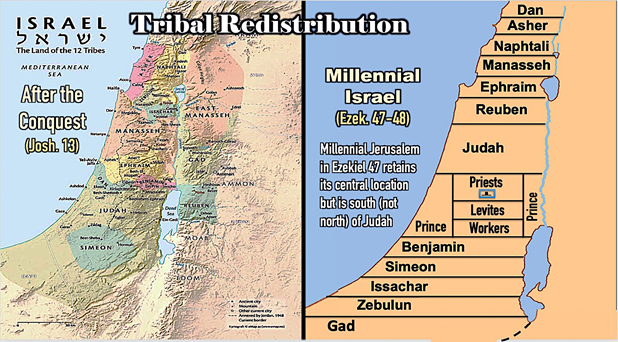
The Description of the Restoration City of Jerusalem
When the Millennium begins topographical changes will occur in and around the city of Jerusalem to create the Millennial mountain which will be elevated above the hills (Isaiah 2:2) as all of the surrounding land will be flattened into a vast plain (Zechariah 14:10). This will be done so that the site of the Lord’s residence with His people occupies the highest situation in the region (hence always visible to the Nation). This will also result in the holy district with the Millennial Temple and Millennial Jerusalem becoming the new center of the Land (Isaiah 2:2; Micah 4:1). The symbolic school finds the immense dimensions ascribed to the Millennial mountain and its holy portion (Temple and city) proof that Ezekiel 40-48 cannot be interpreted literally. However, given such extensive topographical expansion, the new boundaries and dimensions are quite realistic.
The Millennial Jerusalem will have twelve gates named after Jacob’s (Israel’s) sons each measuring 4,500 cubits (2.2 miles). On its northern side (verse 30) the three closest to the Millennial Temple (verse 31) will be named for the tribes of Reuben, Judah, and Levi, perhaps reflecting Reuben’s firstborn status (Genesis 35:23), Judah’s past position as the site of the Temple (Genesis 22:2; Exodus 15:17; Deuteronomy 12:5-6; 2 Samuel 7:10), and Levi’s priestly position (Numbers 3:6). On its eastern side (verse 32) the gates will be named for Joseph, Benjamin, and Dan. As in Revelation 7:8, Joseph represents his sons Ephraim and Manasseh (Genesis 48:1) who were adopted by Jacob (Genesis 48:5-6). The tribe Dan is again distinguished, confirming that its past history will not prevent its future inheritance (see above). The gates on the southern side (verse 33) will be named for Simeon, Issachar, and Zebulun, whose tribal location in the south (48:24-26) meant that each tribe faced the gate bearing its name. On the western side (verse 34) the gates were named for Gad, Asher, and Naphtali.
Some commentators have criticized the seemingly narrow and parochial vision of Ezekiel that focuses almost exclusively on the Land and people of Israel. It appears as though God has returned only to Israel, whose people are alone mentioned having access to the Sanctuary and whose Temple-sourced river refreshes only the native ground. But it must be remembered that the vision came to Ezekiel while he was in exile with Israel and that his message of comfort was directed to the covenant people at a time when the nations were largely estranged from the God of Israel (cf. Ephesians 2:11, 19). If Ezekiel directs his prophetic hope of restoration to Israel, it is also because this promise was made to Israel in its covenant with God (Jeremiah 31:31-33). The election of national Israel has always been a problem to Universalists and replacement theologians, but Ezekiel’s vision should serve as a corrective that God has and will continue through the Millennial Kingdom, to mediate His blessings through His Chosen People (Genesis 12:3; cf. Romans 11:12, 15). However, Ezekiel has not been unconcerned about the fate of the nations, as the constant reminders that God’s intervention for Israel is a witness that He is the Lord (35:15; 36:23; 37:28; 38:23; 39:6, 7). At any rate, there are other prophets who have informed the nations of their promised place alongside Israel as a “blessing in the midst of the earth,” “My people,” and “the work of My hands” (Isaiah 19:23-25).
The fact of theophany distinguishes this Jerusalem from any other Jerusalem in history. The return of the Shekinah will signal the city’s restoration to the divine ideal and usher in the era of its promised blessing. While the Divine Glory will fill the Millennial Temple (43:7a) the extent of the glory on the entire Millennial mountain is such that the Millennial Jerusalem is also made glorious as “the throne of the Lord” (Jeremiah 3:17). According to Isaiah 4:5-6 the whole area of Mount Zion will be covered by the Glory-Cloud as a canopy (literally chupa, like the canopy over the Jewish wedding party) giving brightness by night (verse 5) and shade by day as well as protection from storm and rain (verse 6). This will also provide an independent light source for the city that will illumine it both day and night (Isaiah 24:23; 60:19-20). For this reason the city will be without walls, for the Lord will be a wall of fire around it (Zechariah 2:4-5), and its gates will be open day and night (Isaiah 60:11). This describes the security of God’s Land, which unlike former times, no longer requires protection, because the Lord is with His people and has restored fortunes of Israel with the nations (Zephaniah 3:15b-16, 20). The restored glory of Jerusalem is such that it can no longer be thought of without reference to the reality of God’s Presence. Therefore the name of the city will be renamed “the Lord is there” (Hebrew YHWH Shammah), verse 35b. Jerusalem has had many different names in the past: Ur-Shalem, Salem, Zion, Ariel, Aelia Capitolina, Al-Quds, but this will be its final change in name, for the Lord who defines it will never depart. In a similar way, the character of the city will also be reflected in its being referred to as “the Lord our Righteousness” (Hebrew YHWH Tzidikenu), Jeremiah 33:16, and “the City of Truth” (Hebrew ‘Ir Ha‘emet), Zechariah 8:3.[24] This divine presence will also endue the city with perpetual holiness (Zechariah 14:20-21). For this reason, the tribal allotments have been arranged so as to make the centrality of the Temple a literal, spatial, reality, rather than simply a theological notion (as the symbolic school contends).
5) The Description of the Temple’s Construction Design Requires a Literal Interpretation
Even though the Jewish Sages found the description of the Temple in these chapters to be daunting, they all accepted it as a literal Temple to be built in the period of Israel’s restoration. As one commentator on this section stated: “These chapters are difficult to read without some attempt to draw what Ezekiel describes. Ezekiel was given specific instructions to “declare all that he saw to the house of Israel" (40:4). This is unnecessary if the Temple were to symbolize only general truths.
The detailed measurements invite the reader to sketch out this Temple plan, which, in fact, is what Christian and Jewish exegetes have done throughout the ages.”[25] Maimonides called it "the temple that will be built" and other Jewish scholars explained the design details including Rashi, David Kimhi, Yom-Tov Lipmann Heller, and Meir Leibush ben Yehiel Michal. They all attempted to produce varying sketches of Ezekiel’s Temple structure based on the 318 precise measurements given for rebuilding the Temple (Ezekiel 40:5-42:20). These measurements employ some 37 specific architectural terms that have no discernable connotation other than their normal and natural sense. Although the details seem tedious and repetitious, they are of fundamental importance to those who have been committed with the task of building this future Temple and performing its sacred service (43:10-11). They provide a glimpse into the mechanics of a regulated and orderly sacred society that will characterize God’s future Kingdom and remind us that the same God who gave this design to Israel also provided similar detailed instructions for the sanctified management of the local church (1 Cor. 14:25-49). Just as the local church follows literal instructions given by the Apostles for its operation, so the future Temple was provided literal instructions by the Prophet for its construction and maintenance. This is the impression the average reader has when reading of the Temple’s measurements, structures, courts, pillars, galleries, rooms, chambers, doors, ornamentation, vessels, priests, and offerings. Nevertheless, one of the leading commentators on the book has contended: “the description of the temple is not presented as a blueprint for some future building to be constructed with human hands,” and that “nowhere is anyone commanded to build it.”[26] However, in Ezekiel 43:10-11 we read: “As for you, son of man [Ezekiel], describe the Temple to the house of Israel … and let them measure the plan. And if they are ashamed of what they have done, make known to them the design of the house, its structure, its exits, its entrances, all its design, all its statutes, and all its laws. And write it in their sight, so that they may observe its whole design and all its statutes and do them.” These verses indicate that those Jews who live in the time of the fulfillment of Ezekiel’s prophesied restoration are to build the Temple. Later in this context (43:13-27) when the same kind of architectural measurements and detailed instructions are given for the altar, it is stated that it will be built by “the house of Israel” (verse 18). If the altar of the Temple is to be built, why not the Temple itself? This is in fact the case, for it is this same “house of Israel” to whom Ezekiel is commanded to “declare all that you see …” (Ezekiel 40:4).
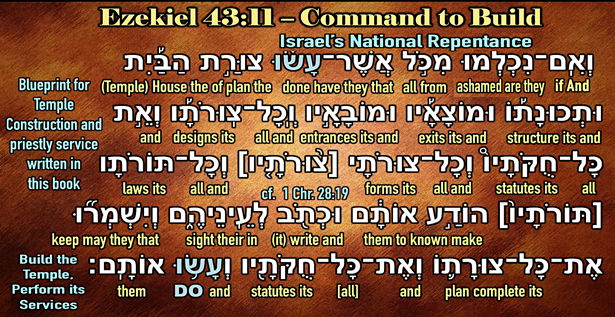
This command in Ezekiel 43:11 to “observe its whole design and all its statutes and do them” is parallel in expression to God’s original command to build a Sanctuary given at Mount Sinai in Exodus 25:8-9. Moses was shown a vision of the Heavenly Temple (Ex. 25:9, 40) and instructed to literally build a copy of it on earth (Ex. 25:8). In like manner, David was given a vision of the design for the First Temple and all of its furniture and utensils and instructions for the priests and Levites, which he gave to Solomon (1 Chr. 28:11-19). If the house of Israel interpreted the earlier vision to Moses and David and their consequent building the Tabernacle and First Temple and the establishment of the priesthood literally, why would they not likewise interpret the same with respect to Ezekiel and God’s command to them? It is exegetically and theologically inconsistent to deny to Ezekiel an interpretation accepted in Exodus and Chronicles.
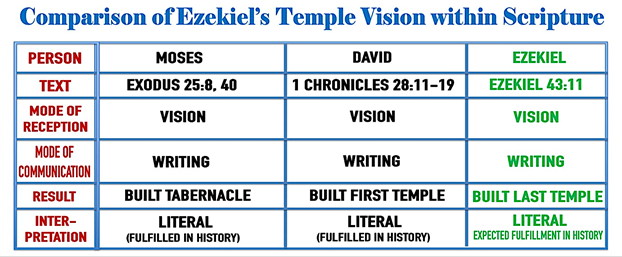
If we consider the detailed description of the Temple, we discover that the plans communicated to Ezekiel are so precise that blueprints could be drawn and a building constructed from them when conditions permitted. In fact, a physical three-dimensional model of this Temple has already been made by John Schmitt, the Executive Director of Messianic Temple Ministries[27] and numerous other digital reconstructions can be found online.
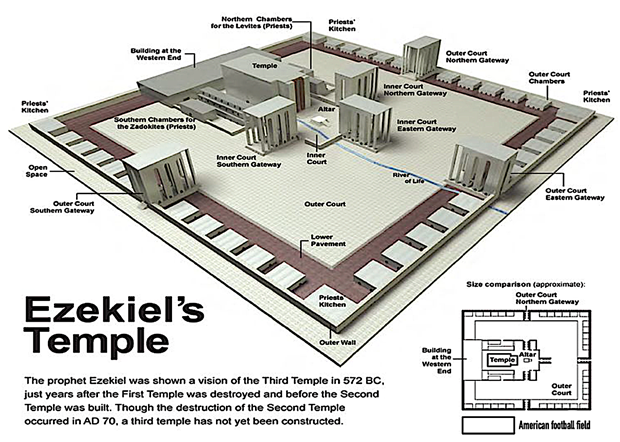
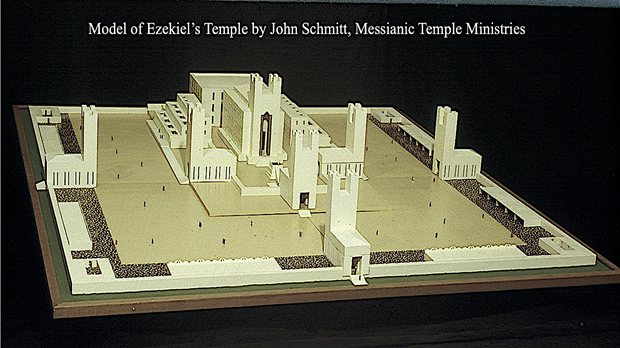

When a comparison is made between the details for the construction of the Temple buildings and the sacrificial system in Ezekiel and those recorded elsewhere for the construction of the Tabernacle and First Temple and their service, there is no reason to take them as less literal or historical. Would Ezekiel have been given such elaborate and practical instructions if only spiritual or symbolic realities were intended? Would the house of Israel be expected to interpret them in any manner other than that which was consistent with God’s revelation of previous structures, especially in the absence of any guidelines for an alternate (symbolic) interpretation?
Although it is possible that symbolical and spiritual significance can be discovered in the details of the Tabernacle and Temple’s construction and ceremonies, it is interesting that such symbolism is not directly revealed in the Bible. Of course, there is an analogous use of ritual language in relation to the spiritual service of the believer (Romans 12:1-2; 1 Corinthians 3:16-17; 6:19) and of the Spirit-filled Church (Ephesians 2:21-22), but this is not the same as typology where a type is fulfilled by an antitype. Even in a book such as Hebrews, in which a comparison is made between Israel’s liturgical system and the believer’s gracious access in Christ, and where such a symbolic significance might be expected, only a description of the Tabernacle and its furniture is given (Hebrews 9:1-5). This passage does refer to the “outer Tabernacle” as a “symbol” (or “figure,” “illustration”) [Greek, parabole] for “the present time” (verses 8-9). The interpretation of these verses are much debated,[28] but their main point is that the Levitical system was weak in that it offered only limited and exclusive access to God’s Presence. But, as one writer has noted, “This does not mean that the Levitical system was bad or that it did not accomplish the purpose for which God instituted it.”[29] However, even if the Scriptures were replete with symbolical and spiritual uses of the entire Levitical system with its Sanctuary, this would in no way affect their literal interpretation. John Whitcomb, long time professor of Old Testament at Grace Theological Seminary, makes this point when he says:
The fact that its structure and ceremonies will have a definite symbolical and spiritual significance cannot be used as an argument against its literal existence. For the Tabernacle was a literal structure in spite of the fact that it was filled with symbolic and typical significance. Such reasoning might easily deny the literality of Christ’s glorious Second Coming on the basis that the passages which describe His coming are filled with symbolical expressions (see Matthew 24 and Revelation 19).[30]
Therefore, even if one could impute symbolic meaning to the Temple and ritual descriptions in Ezekiel 40-48 (although in the Old Testament there is no precedence for this and in the text no guide for understanding the symbolism), there is no reason why the fulfillment should not be as literal as for every Temple and priesthood of the past.
6) The Harmony with other Old Testament Prophetic Passages Requires a Literal Interpretation
The same text that commands the house of Israel to build the Temple also states the time when they are to build it: after “they are ashamed of all that they have done” (Ezekiel 43:10-11). The time of this national repentance accords with the eschatological period previously described in the restoration text of Ezekiel 36:22-38 in which Israel has been made “ashamed” as part of the regenerative work of the Spirit (Ezek. 36:30-33; cf. Zech. 12:10-13:1). Just because the exilic community expected restoration does not mean that what they experienced upon their return was what Ezekiel (and other prophets) had prophesied. After the exile only a small remnant returned to Judah (Ezra 2:64–69), the rebuilding of the Second Temple under Zerubbabel was disappointing (Hag. 2:3) and the Zadokite priesthood functioned only until the rise of the Hasmoneans (c. 167 BC). This demonstrated that the post-exilic community had not experienced the physical aspects promised by the prophets for the restoration. In addition, the inability of the post-exilic community to find the fulfillment of the restoration spiritually was revealed by their repeated covenantal violations: those who returned to Judah continued to disobey the Mosaic law (see Ezra 9:1–2; 10:10–14: Neh. 5:1–10; 13:15–18; Zech. 1:4–8). These facts indicate that they were intended for fulfillment once the Messiah establishes theocratic rule under the new covenant (Ezek. 36:25–28; 37:26-28; Jer. 31:31–34) with national Israel in the Promised Land (Ezek. 37:21–22), which will result in renewal politically (Ezek. 34:23–25a; 37:24-25; Zech. 14:9, 16-17), materially (Ezek. 34:25b–29; 36:29-30, 37-38), and spiritually (Ezek. 34:30–31; 36:25-28, 33; 37:11-14).
Jewish tradition sought to give hope to the Jewish community over the obvious failure of their post-exilic ancestors saying God told Ezekiel that this would not be fulfilled at the return from Babylon (Jer. 27:22), but that the plan revealed to him would still affect a godly purpose. According to the Midrash: “Learning in the Bible about the description of My House is as great as the building of it. Go and tell the Jewish people to occupy themselves in learning about the Temple, and in that merit I will consider I as if they are actually involved in building it” (Yalkut Shimoni on Ezekiel 43:10-11).
Even the commentator cited previously who sought to place this prophecy’s fulfillment in the return of 538 B.C. and rebuilding of the Temple in 516 B.C. still postponed the fulfillment of chapter 47:1-12 to the time of the Messiah. Why should only this portion of the prophecy be considered as having its fulfillment in the messianic age? The same question must be posed to those who have thought that the form of government in these chapters reflects the religious polity of the restoration community under the Persian administration of Darius I.[31] This is unwarranted for in other prophetic texts this kind of restoration government is clearly reserved for the eschatological kingdom of Israel.[32]
If Ezekiel’s prophecies were meant to be fulfilled historically in the Second Temple they must be considered a failure. Any attempt to make the Second Temple fulfill these restoration prophecies force us to either abandon literal interpretation, which, as we have seen, the details of the text do not allow, or admit that the Word of God itself has failed, which orthodox theology cannot allow. For this reason Jewish interpreters concluded that the Second Temple was not built according to Ezekiel's plan because it was not yet the time to build this Temple. Rashi, one of the greatest Medieval Jewish commentators, explained this when he wrote:
The return to Israel in the days of Ezra could have been like the first time the Jewish people entered Israel in the days of Joshua …However, sin prevented this, for their repentance was imperfect. Since they were not worthy, they did not have permission to build the Temple which was designated as the Temple for the eternal redemption, for when it will be built according to this design, the [divine] glory will rest upon it forever.[33]
One objection to the eschatological interpretation of chapters 40-48 is the alleged absence of eschatological language such as “on that day,” “in the latter days,” which appear in chapters 34-37, and especially 38-39. However, as noted above, the literary linkage to these chapters establishes an eschatological setting as does the description of the transformations of the Land, city of Jerusalem, Temple, and priesthood from the past. The unprecedented change from the laws of the past, the return of the Glory of God (Ezekiel 43:1-12), the extended holiness of the Temple Mount, the physical changes in the Land of Israel (Ezekiel 47:1-12), the enlarged boundaries of the Land (Ezekiel 47:13-23), and God’s Presence dwelling in an enlarged Jerusalem (Ezekiel 48:35) all serve to indicate that the time of fulfillment is eschatological. This is especially seen when these details are compared with similar accounts of a future Temple, raised Temple Mount, and restored conditions in other prophetic books of the Old Testament, most of which do contain these eschatological time markers such as Isaiah 2:2-4; 56:6-7; 60:10-22; Jeremiah 3:16-17; 31:27-40; 33:14-18; Joel 3:18-21; Micah 4:1-8; Haggai 2:7-9; Zechariah 6:12-15; 14:16, 20-21. Specifically, we may categorize those related only to the Temple and its ceremonies as in the chart below. These demonstrate that Ezekiel’s prophecies related to Temple, priesthood and the sacrificial system were shared concepts related to fulfillment in Israel’s time of restoration. It is also evident that the Prophets read one another’s writings (since they were recorded divine revelation like their own) to learn and develop the revelation imparted to them (intertextuality).
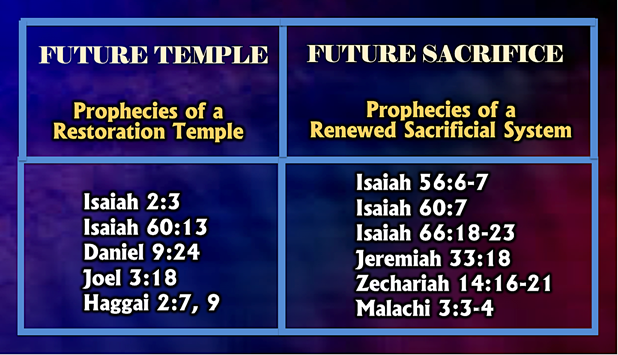
When we consider the restoration of the Levitical priesthood in Ezekiel we find that it not only that other prophetical books agree, but that Ezekiel’s prophecy is the most complete statement of their fulfillment. In fact, the ancient promises to the Levitical priesthood have no literal fulfillment unless Ezekiel’s prophecy is eschatological. God promised to Zadok was the Aaronide high priest at the time of David and Solomon (1 Samuel 8:17; 15:24; 1 Kings 1:34; 1 Chronicles 12:29) and his descendants an everlasting priesthood (1 Samuel 2:35; 1 Kings 2:27, 35). This promise was the reconfirmation of similar promises made to Zadok’s ancestor Phinehas (Numbers 25:13), and Phinehas’ grandfather Aaron, the progenitor of the Israelite priesthood (Exodus 29:9; 40:15). The Zadokite priesthood was the dominate priesthood up until the time of the Maccabean revolt after which it was corrupted and replaced by political appointments to the priesthood under the Hasmonean dynasty. Thus, the last priests serving the Temple when it was last destroyed in A.D. 70 were not of the legitimate Zadokite line. Jewish sects like those at Qumran, who claimed to be Zadokite priests (1QS 5:2, 9; 1Qsa 1:2, 24; 2:3; 1Qsb 3:22), rejected the Jerusalem Temple and its priesthood and expected their priesthood to regain its position of service in a future Temple to be rebuilt after a climatic end time war in which the Hasmonean priests would be punished (1 QpHab 9:4-7; 4QpNah 1:11).[34] Only Ezekiel unequivocally provides the fulfillment of the promise to the sons of Zadok by making them the priests that serve the Millennial Temple (Ezekiel 40:46; 44:15). Ezekiel’s contemporary Jeremiah in his prophecy linked the perpetuity of the Levitical priesthood with the perpetuity of the Davidic dynasty and guarantees it by the perpetuity of the earth’s rotation on its axis (Jeremiah 33:17-22). If Ezekiel’s prophecy of a future Zadokite priesthood is spiritualized, then, according to the linkage in Jeremiah’s prophecy, the promises of the Davidic Covenant (2 Samuel 7:13, 16) could also be spiritualized. This would put all messianic fulfillment in jeopardy (including that fulfilled in Jesus)! Consequently, if we accept a literal and eschatological fulfillment for the Levitical priesthood we must also accept it for the Temple which they serve. In addition, if 12,000 can be sealed from the tribe of Levi during the Tribulation period (Revelation 7:7), then a literal restoration of the Levitical priesthood after the Tribulation is certainly plausible. Therefore, in harmony with other prophets, Ezekiel depicts an eschatological restoration of which the Temple and its priesthood are an essential part.
7) The Requirement of Sacrifices in Ezekiel’s Temple Requires a Literal Interpretation
Reformed teachers argue against dispensationalism on the grounds that a literal interpretation of animal sacrifice in Ezekiel 40-48 is both contradictory to New Testament texts and theologically heretical. Reform scholars such as Oswalt Allis and Edmund Clowney call the view an embarrassment to the dispensationalist because “it requires the reestablishment of the Mosaic sacrifices and the Aaronic priesthood which, according to the Book of Hebrews, have ended.”[35] Former Dallas Theological Seminary student and Reformed scholar Keith Mathison expanded on this point in his study on Dispensationalism:
Dispensationalists understand Ezekiel 40-48 to be a prophecy of the future millennial temple and the worship that will occur there. The problem is that there are numerous passages in these chapters that depict the practice of animal sacrifices (40:38-43; 42:13; 43:18-27; 44:11, 27, 29; 45:13-25; 46:2-7, 11-15, 20). These verses should not be interpreted literally and placed in a future millennium. Hebrews 10:10-18 forbids it: “Now where there is forgiveness of these things, there is no longer any offering for sin” (v. 18). According to Hebrews the purpose of the sacrificial system has been fulfilled. The once-for-all sacrificial death of Christ has forever ended the offering of animal sacrifices. Some dispensationalists answer that these animal sacrifices will merely be memorials offered in remembrance of Christ’s death. But that is not what Ezekiel literally says. Ezekiel calls these offerings “sin offerings” (40:39; 43:19, 21, 22, 25; 44:27, 29; 45:17, 22, 23, 25; 46:20). And Hebrews 10:18 says that after Christ’s death there is no more offering for sin. Moreover, the offerings in Ezekiel 45:15, 17 are literally said to make atonement … It is impossible to interpret Ezekiel 40-48 in a strictly literal manner in reference to a future millennium without denying the clear teaching of Hebrews on the final sacrifice of Christ. To do so introduces a contradiction into Scripture …[36]
When the Temple was standing its most central function was as a site for sacrificial worship. Every Jew we read about in the Bible sacrificed, from Abraham, the father of the Jewish Nation, to Jesus, the founder of Christianity.[37] When the Temple was destroyed in A.D. 70 it brought a cessation to this sacrificial system for Judaism. Yet, despite this loss, Jewish liturgy preserved the ancient Temple services, recounting the sacrifices verbally in accord with the verse in Hosea (14:3): "So we shall render for bullocks the offering of our lips." In the words of the Talmud: "The prayers were instituted in correlation to the tamid sacrifices." The tamid, or olat ha-tamid was a twice-daily offering, morning and evening, of a male lamb. Yet, even though the sacrifices were continued in symbol, Jewish orthodoxy maintained the belief that they would return in substance with the Third Temple. This hope is clearly supported in Ezekiel’s prophecy of the Final Temple where detailed instructions concerning the priestly sacrificial service are elaborated.
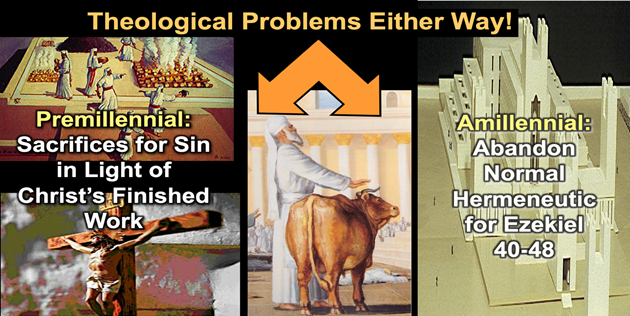
Every interpreter of the last chapters of Ezekiel must wrestle with the fact that out of these nine chapters there is a statement concerning the sacrificial system in every chapter but one (chapter 47). These references include: “new moons and sabbaths … all the appointed feasts” (Ezekiel 44:24; 45:17; 46:3, 11-12), “daily offerings” (Ezekiel 46:13-14), “burnt offerings, grain offerings, and the libations” (Ezekiel 45:17; 46:2, 4, 11-15), “blood sacrifices” (Ezekiel 43:20), an “altar” for burnt offering (Ezekiel 40:47; 43:13-27), an “altar” for incense offering (Ezekiel 41:22), “boiling places” to “boil the sacrifices of the people” (Ezekiel 46:23-24); a “Zadokite” priesthood to “offer Me the fat and the blood” (Ezekiel 40:46; 42:13-14: 43:19; 44:15-16; 48:11), a “Levitical” priesthood to “slaughter the burnt offering” (Ezekiel 44:10-11; 48:22). Furthermore, the offerings are stated to be for “a sin offering” (Ezekiel 43:22, 25; 44:24, 29) and to “make atonement” (Ezekiel 43:20; 45:25). Since the sacrifices and sacrificial personnel are so prominent throughout these chapters, the treatment of the sacrifices cannot be avoided as incidental.
Therefore, the first question that must be answered is whether these references to “sacrifice” are intended as symbol or substance? These options are not merely academic concerns but have significant theological implications. As the late German prophetic scholar Erich Sauer states: “We stand here really before an inescapable alternative: Either the prophet himself was mistaken in his expectation of a coming temple service, and his prophecy in the sense in which he himself meant it will never be fulfilled; or God, in the time of Messiah, will fulfill literally these prophecies of the temple according to their intended literal meaning. There is no other choice possible.”[38] However, the option most commonly resorted to by interpreters is to abandon a literal interpretation of all of Ezekiel’s prophecy in chapters 40-48 in preference of the symbolic. This is at least a consistent interpretation, since if spiritualize the sacrifices we must do the same for the Temple and with all the detailed promises of Israel’s restoration.
An example of the abandonment of literal fulfillment, on the basis of the supposed non-repetitive nature of the sacrificial system post-Jesus’ atoning sacrifice has been voiced by none other than a professor at a dispensational seminary:
The inclusion of so many minute details suggests that the temple described here will be a literal reality in the Jerusalem of the future (see Isa. 2:2–4; Hag. 2:9). However, the final sacrifice of Jesus Christ has made the Levitical system obsolete (see Heb. 9:1–10:18). To return to this system, with its sin offerings and such, would be a serious retrogression. Ezekiel’s audience would have found it impossible to conceive of a restored covenant community apart from the sacrificial system.132 Now that the fulfillment of the vision transcends that cultural context, we can expect it to be essentially fulfilled when the Israel of the future celebrates the redemptive work of their savior in their new temple. Ezekiel’s portrait of the Davidic king, or “prince,” is also contextualized to some degree. The king leads the community in worship and must even offer sacrifices for himself. Ezekiel also seems to anticipate the establishment of a dynastic succession (see 45:8; 46:16–18). Ezekiel’s audience would have found this portrayal quite natural. However, Jesus, the one who fulfills the vision, will have no need to offer such sacrifices, nor will he institute a dynasty. On the contrary, he will reign over his kingdom forever.[39]
The consistent literal school of interpretation is the only system able to interpret the references to sacrifice in a manner that is consistent with the uses of these terms throughout the Old Testament. Where else in the Old Testament is the priesthood, the altar, the feasts, the offerings, and the sacrifices made typical or symbolic of any other truth? If the New Testament is suggested as the key to interpret it symbolically, how did those Jews, for whom the book was written, interpret the book for over 600 years while waiting for this key? But even if the New Testament suggests a spiritual pattern for interpreting the sacrificial system, it provides no specific pattern that enables one to interpret the sacrificial references in Ezekiel. For this reason, there can be no consistent interpretation of this text by the symbolic method and therefore, no clear understanding of its message. Moreover, the symbolic approach has to deal not only with the references in Ezekiel, but with numerous other references to sacrifices within eschatological contexts (see, Isaiah 56:6-7; 60:7; 66:20-21; Jeremiah 33:18; Zechariah 14:16-21; Haggai 2:7; Malachi 1:11). For example, one of these in Jeremiah 33:17-23 prophesies: “For thus says the Lord, ‘David shall never lack a man to sit on the throne of the house of Israel; and the Levitical priests shall never lack a man before Me to offer burnt offerings, to burn grain offerings, and to prepare sacrifices continually … Thus says the Lord, ‘If you can break My covenant for the day, and My covenant for the night, so that day and night will not be at their appointed time, then My covenant may also be broken with David My servant that he shall not have a son to reign on his throne, and with the Levitical priests, My ministers, as the host of heaven cannot be measured, so I will multiply the descendants of David My servant and the Levites who minister to Me.” Can this prophecy be spiritualized to find fulfillment in David as Christ and the Levites as Christians? This is not possible because the fulfillment of the prophecy in Jesus depends upon a literal fulfillment as the “son of David” by physical lineage (see Matthew 1:1), which the symbolical school accepts. It would be hermeneutically inconsistent to take the prophecy to David literally and the prophecy to the Levites as spiritual, especially since they are bound together in a dual promise of perpetuity whose fulfillment is divinely guaranteed. Therefore in the same way the fulfillment of this prophecy for the Levites depends upon their being the physical descendants of Levi. To take this other than literally would be to remove it (in the case of David) from the rank of messianic prophecy, yet it is also obvious that to find a literal fulfillment in any time but the future would be to admit that this prophecy has failed. The fulfillment, then, must take place with Christ reigning on the throne of David in the Millennial Jerusalem and the Levites ministering through the sacrifices in a rebuilt Temple.
It is also remarkable, from the symbolic point of view, that the main passages dealing with the sacrifices in Ezekiel (the altar of burnt offerings, the priests and Levites, the sacrificial offerings) are introduced immediately after the Ezekiel 43:1-12 in which the Glory of God returns to the Temple Mount to restore its sanctity and bring an extended new spiritual dimension to Israel (verse 12). The contrast with the old defiled order is described in terms of there no longer being any of the former abominations in the Temple (verses 8-9), and it is only on the condition that Israel is truly “ashamed of all that they have done” (verses 10-11a) that the design of the Temple is to be made known and its statutes performed (verse 11b). If, according to the symbolic school, the old sacrificial system had truly been fulfilled by Christ’s sacrifice, which in the symbolic view would be represented by the coming of the glory of the Lord into the Temple, then why would sacrifice symbolically follow as part of this new design? By this interpretation it should have been part of the old order of abominations for which Israel should have been ashamed.
Some have argued that Isaiah 66:3-4 depicts a condemnation of sacrifice itself, or else in its eschatological context, of future Temple sacrifices (see chapter 21). But in this passage is it the reinstitution of the sacrificial system that which is rejected? Rather, it is the attitude of unbelief, characterized by self-sufficiency and the arrogance of self-merit, that is condemned. This attitude, which is properly addressed at the rebuilding of the Temple and the re-institution of the sacrificial system (verses 1-2) was also condemned at previous Sanctuaries (1 Samuel 3:22-35; 4:3-11; 6:19; 13:12-13; 2 Samuel 6:6-8; 2 Kings 15:5/ 2 Chronicles 26:16-23). This verse is saying what the Prophet Samuel to Saul about selective obedience based on one’s own way: “Has the Lord as much delight in burnt offerings and sacrifices as in obeying the voice of the Lord? Behold, to obey is better than sacrifice, and to heed than the fat of rams …” (1 Samuel 15:22). It is saying the same thing as Solomon said when he wrote: “The sacrifice of the wicked is an abomination …” (Proverbs 21:27a), and “He who turns away from listening to the law, even his prayer is an abomination” (Proverbs 27:9). Therefore, such biblical condemnations of ritual violations in sacrifice cannot be used as examples of a divine rejection of the sacrificial system. Instead, the importance attached to keeping the ritual pure only strengthens its significance for proper worship.
But was not Christ’s sacrifice the end of all sacrifices? The answer to this requires us to consider the purpose of the Old Testament sacrifices as well as the nature of Christ’s redemptive work (see below). However, one point that needs to be understood is that “just because animal sacrifices and priests have no place in Christianity does not mean that they will have no place in Israel after the rapture of the Church …”[40] The problem this statement raises is the failure to discern the distinction between the ages preceding and subsequent to the present age of Grace. As Clive Thompson notes:
The basic error in this question is the assumption, usually unconscious, that the conditions which prevail in this age of grace must necessarily be the same in all future ages, that the relations between God and man which exist now must continue to the end of time … He will again bring forward His people Israel, the only nation He has ever recognized (Amos 3:2), and deal with them and with the Gentiles on a basis of law, although necessarily modified by grace as in the Mosaic dispensation. This follows for at least three reasons: (1) The age or dispensation of grace ends at the rapture and is never to be repeated. (2) In all other ages God deals with man on a law relationship. (3) All left on earth are God’s enemies and must therefore be dealt with by law. Law is, and must be, accompanied by sacrifice. A repentant Israel must join in such sacrifices; and repentant Gentiles must conform and join therein also.[41]
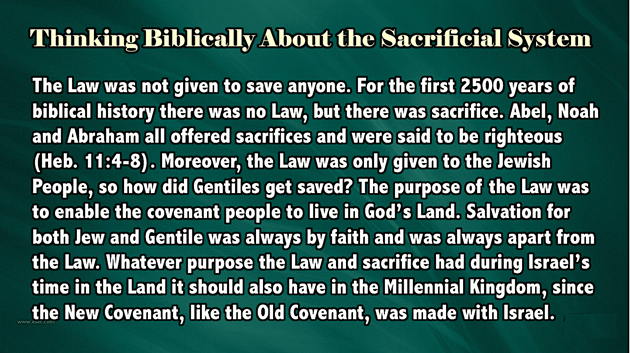
New Covenant Sacrifices
The failure to distinguish between God’s purposes and performances for National Israel and the Church makes it impossible for non-dispensationalists to understand the concept of the resumption of the sacrificial system under the New Covenant. They argue that it is a denial of Christ’s finished work and a return to the Old Covenant (which is also misunderstood since the warning in Hebrews relates to a denial of the sufficiency of Christ’s sacrifice that seeks to add ritual fidelity as a necessary work. However, as John Whitcomb has observed: “The Bible clearly teaches that while there is no such thing as an earthly Temple, an altar, or animal sacrifices in true Christianity (John 4:21, Heb. 7-10), there will be such provisions for Israel following the rapture of the Church (Matt. 24, 2 Thess. 2:4, Rev. 11:1,2. Compare also Hosea 3:4,5 with Daniel 9:24, 27).”[42]
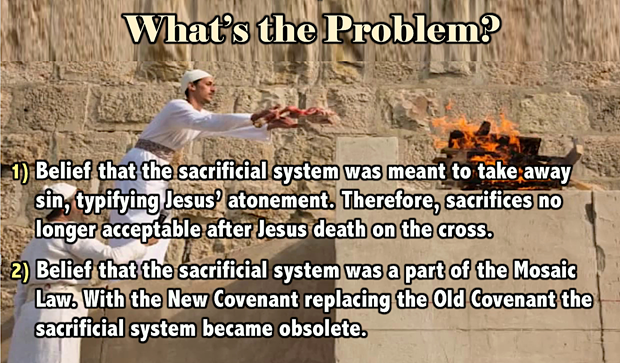
The dispensation of the Church is a eschatological interregnum that by its nature of Jew and Gentile baptized by the Holy Spirit equally into position with Christ (1 Corinthians 12:13) could not fulfill the distinct restoration prophesies for Israel and the nations. The Church Age is not simply the incorporation of Gentiles (Romans 11:11-24, 30) into the place of privilege (the “olive tree” of Romans 11:17-24) but the integration of Gentile and Jew in one body under the law of Christ (Ephesians 2:14-16; 1 Corinthians 9:21; Galatians 6:2). By contrast, the Millennium is an eschatological extension of the Jewish Age which involves the inclusion of Gentiles into an earthly Jewish economy (Isaiah 2:2-3; 56:6-7; 66:18-21) under the theocratic laws of the New Covenant which include physical sacrifices at a physical Temple (Isaiah 66:20-21; Zechariah 14:16-18). Therefore, in the present age the Church serves as a “spiritual temple” (Ephesians 2:20-21) with “spiritual sacrifices” (Romans 12:1; Hebrews 13:15-16) and spiritual access through Christ and prayer to the Heavenly Temple (Hebrews 4:14-16; compare 12:22-24). However, once the Church
Age has run its predetermined course (Romans 11:26), the “spiritual temple” will be replaced by the “physical Temple” in conformity with the return of national Israel to the divine program (Romans 11:27). Accompanying this return will be many of the former physical elements that are essential to Israel functioning as a theocratic Nation. The reason for this is that the Church Age is set between the failure of Israel under the Old Covenant and the restoration of Israel under the New Covenant. Unlike the Church which is governed indirectly by Christ through the Spirit and was not promised an earthly kingdom, Israel was governed directly by God (theocracy), and will be through the Messiah, and was promised an earthly kingdom. Israel’s promised Restoration in the Last Days will not take place within the Church but it will take place within the New Covenant. It is not the place of privilege promised to national Israel, the Temple or the sacrificial system that has been set aside by this New Covenant, but the old Mosaic Covenant. Even though this covenant had included this promise and institution, by design these were pre-Moasic, being included respectively in the Abrahamic Covenant (Genesis 12:2-3) and the divine design. Moreover, this replacement was prophesied not in the New Testament but the Old Testament. The two principal prophecies of the New Covenant in the Old Testament are in Ezekiel (Ezekiel 36:25-28) and Jeremiah (Jeremiah 31:31-34). According to the literal interpretation of these texts, national Israel will realize the spiritual and physical (Land) blessings of the New Covenant only in the eschatological age (Ezekiel 36:29-36; compare 34:25-29; 37:25-28; Jeremiah 31:31, 33). The restoration the Nation will enjoy under this covenant will involve “all Israel” - “the house of Judah and the house of Israel” (Ezekiel 36:22, 32; compare 37:19-23; Jeremiah 31:31, 37), with the corporate Nation experiencing individual spiritual regeneration (Ezekiel 36:26-27; Jeremiah 31:33-34).
One example of Jesus’ own understanding of this is His promise to His disciples at their last Passover together in the upper room. In each of the Synoptic Gospel’s account, Jesus takes the cup and pledges that He will drink it again with them in the Kingdom Age (Matthew 26:29; Mark 14:25; Luke 22:18).[43] This implies that the Jewish festival of Passover will again be celebrated in the future Kingdom.[44] This implication is made explicit in Ezekiel 45:21: “In the first month, on the fourteenth day of the month, you shall have the Passover …” It should be obvious that if the Passover will be celebrated in the Millennium that the Passover sacrifice, the central feature of the feast, must also be resumed. Until then, the Church may celebrate the feast in its spiritual dimensions (without a sacrifice), as Judaism does today, since “Christ our Passover has been sacrificed” (1 Corinthians 5:7-8).
The problem with the Mosaic Covenant was not its ritual but its requirements. Israel could not keep its conditional requirements and therefore a superior and unconditional covenant was necessary which could guarantee the fulfillment of its requirements. The New Covenant’s provision of spiritual regeneration will make possible the spiritual obedience of the Nation that was lacking under the Mosaic economy, thereby preventing any further loss of relationship with God, the Land, or the Temple. That certain ritual aspects of the Mosaic Covenant remain under the New Covenant is to be expected, since the divine ideal is for the Creator to dwell with His creatures in an uninterrupted relationship (see Zechariah 2:10-11 and chapter 3). Even so, the significant legal differences in the ritual under the New Covenant confirms it is not a repetition of the Mosaic Covenant. This ritual, the focus of which was the regulation of a relationship between God and man through sacrifice, as already mentioned, was initiated with Adam and Eve (see Genesis 3:20; 4:3-7),[45] and continued in the Abrahamic Covenant (Genesis 15:1-18), long before the Mosaic legislation was enacted.
The physical nature of life in the Millennial Kingdom will require that there still be a regulation in this relationship (the Temple and ceremonial system), but the spiritual conditions of this period (a theocratic government, a regenerate populace, universal peace, no threat from the nations, etc.) will have made all other aspects of the Mosaic Covenant unnecessary and obselete.[46] For example, Ezekiel 43:17 states that the altar of burnt offering in the Millennial Temple will have “eight steps facing east.” Under the Mosaic Law this altar would have been illegitimate because its stipulations prohibited both going up “steps to My altar” (Exodus 20:26) and an eastward orientation. Therefore, the altars in previous Temples were constructed with a “ramp” for priestly ascent (see Mishnah, Middot 3:4) and with a north-south orientation. The reason for this prohibition (as well as the commandment in Exodus 28:42 concerning the priests wearing linen underwear) was because of Israel’s proximity to the Canaanite culture whose priests ascended stepped altars to reveal their nakedness as part of their sacrificial rituals which involved the worship of nature and fertility deities. In addition, they worshipped the god Shamash, who represented the sun that rises in the east. The need to separate both literally and symbolically from this and similar pagan cultures and rituals resulted in much of the Mosaic legislation.
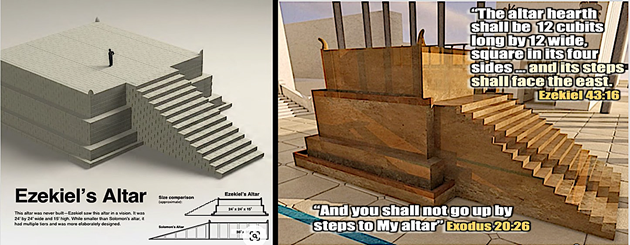
However, in the Millennial Kingdom their will be no foreign counter cultures such as the Canaanites (see Zechariah 14:9), all the nations will worship the Lord (see Zechariah 14:16-19), and Jerusalem will be holy and beyond contamination (see Zechariah 14:20-21). Therefore, there will be no need to continue such laws of the Mosaic economy. In addition, it has been suggested that the reason for Ezekiel’s eastward orientation of the altar was so that the priests will be able to face in the direction of the Messiah who will be enthroned in the Temple.[47] Incidentally, this reveals how radically the Millennial sacrificial system deviates from that prescribed under the Mosaic Covenant.[48] It was for this reason that post-exilic Judaism did not attempt to employ these new ritual commandments, because they understood them not as a reinstitution of the Mosaic system, but as functioning under Jeremiah’s prophesied New Covenant in the Millennial Kingdom. This remains the best solution to resolving these contradictions with Mosaic Judaism in Ezekiel’s text.
With this understanding, let us consider the two ways in which the literal school of interpretation has explained the nature of the Millennial sacrifices.
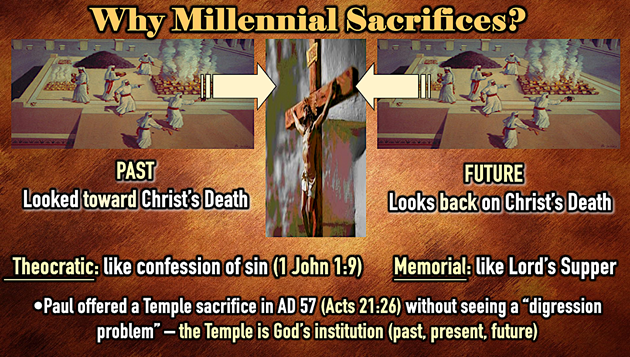
The Memorial View of Millennial Sacrifices
The majority of those who hold a consistently literal interpretation of this text maintain that the sacrifices will be memorials of the sacrifice of Christ. This view has been advocated by many classical dispensationalists such as A. C. Gaebelein, Charles Feinberg, J. Dwight Pentecost, Eric Sauer, Ralph Alexander, and Lamar Cooper. Paul Benware explains memorial view’s principal argument:
These sacrifices do not take away sin in the millennial age any more than animal sacrifices did in Old Testament times. Their purpose seems to be that of being a vivid re-minder of the Lord's death. As the Lord's Supper is a reminder of the death of Christ to the church today, it is probable that the animal sacrifices will uniquely memorialize Christ's horrible death on the cross. This will be a powerful teaching tool to people born in an age where righteousness and holiness prevail-in an age that is so free from the external effects of sin that its exceeding sinfulness is not clearly understood.[49]
John F. Walvoord, Chancellor of Dallas Theological Seminary, says: “The Scriptures also tell us that in the Millennial Kingdom, which begins with the Second Coming of Christ, there will be a huge Temple built as described in Ezekiel chapters 40-48 … And we learn here that there will be animal sacrifices offered. The question is often asked why this is necessary, and the answer is simply that it is a memorial, a reminder of the death of Christ, just like the Old Testament sacrifices were in anticipation of it.”[50] As Dr. Walvoord has stated, this view finds scriptural precedent in the Lord’s Supper which was done “in remembrance” of Christ (Luke 22:19; 1 Corinthians 11:24). Since this ordinance is only “until He [Christ] comes” (1 Corinthians 11:26), another such reminder of Christ’s redemptive work will be necessary for the generation that populates the Millennium.[51] Therefore, in contrast to the Old Testament sacrifices that were prospective (looked forward to the fulfillment of the cross), these millennial memorials will be retrospective (looking back at the accomplishment of the cross). However, some have added that since the Lord’s Supper also proclaimed the future coming of Christ (1 Corinthians 11:26) and the Kingdom (Matthew 26:29; Mark 14:25; Luke 22:18), these sacrifices will warn of future wrath at the coming Great White Throne judgment, especially for those who will rebel at the end of the Millennium and join in the Satanic attack on the Temple Mount (Revelation 20:7-11).[52]
In line with this interpretation is the understanding that Old Testament sacrifices were only symbolic. The late commentator Charles Lee Feinberg states: “… the function of Old Testament sacrifices … were never efficacious; they were never meant to be expiatory, that is to care for the penalty of sin; they were never meant to be anything but symbolic of the forfeiture of life for sin …”[53] This view, however, fails to address the fact that Ezekiel (Ezekiel 43:20, 26; 45:15, 17, 20) under the New Covenant clearly says that the blood sacrifices are for “atonement” in just the same way that Leviticus (Leviticus 4:20, 26, 35; 16:27; 17:11, et. al) does under the Mosaic Covenant. As Charles C. Ryrie observes:
However compelling and non-conflicting (with the concept of the once for-all sacrifice of Christ) the memorial view may be, it is insufficient to explain the details recorded concerning the sacrifices and the fact that it is said that they relate to "atonement" (Ezekiel 43:20, 26; 45: 15 , 17, 20).[54]
While the sacrifices could also have a memorial purpose nowhere in Ezekiel’s prophecy (nor in comparable New Covenant texts) concerning the sacrificial system is it ever implied that the sacrifices are memorial in nature. For this reason, another literal view has been advocated which attempts to consistently interpret these sacrificial references.
The Atonement View of Millennial Sacrifices
The atonement view is also advocated by classical dispensationalist such as John Whitcomb and Charles Ryrie. Just as it is insufficient to say that Ezekiel’s Temple is symbolic of God’s spiritual dwelling with His people, so it is insufficient to say that the animal sacrifices in Ezekiel’s Temple were only symbolic of the final sacrifice of Christ. There are a number of reasons that the millennial sacrifices, like the Millennial Temple, are literal and had a function that effected literal atonement.
First, it is apparent that when an offerer in Old Testament time went to the altar that he came away believing that something happened that was immediately and personally significant for his relationship with God. Second, there is simply no evidence in the presentation of the sacrificial worship of the Old Testament that indicates each and every Israelite offerer throughout the entire span of Old Testament times understood that their offering was anticipatory of a sacrificed Messiah. To argue this is to deny the nature of progressive revelation that unfolded the redemptive program throughout the ages. While God always had the death of Christ in view as the basis of eternal salvation, the faith of the Israelite rested on God their Savior who promised life for life in the substitution of an animal’s life-blood for their own (see Genesis 22:8, 13-14). Third, living so long with the historical loss of sacrifice has diminished the importance of the concept of sacrifice for us today. As E. P. Sanders, Oxford University Professor of Exegesis, reminds us: “Modern people so readily think of religion without sacrifice that they fail to see how novel that idea is.”[55] Therefore, to understand Ezekiel’s concept of sacrifice it is necessary to understand the purpose of sacrifice as it was presented in the Old Testament.
Making Sense of “Sacrifice”
Both ceremonial purification (considered holy) and substitution is at the heart of the concept of sacrifice. The English word “sacrifice” hints at this dual idea in its original derivation. As Jewish scholar Joshua Berman, author of a major Jewish study on the Temple, explains:
The [English] word sacrifice is a conjunction of two Latin words, sacer – holy – and facere – to make. When one offered a sacrifice in the Greco-Roman world, it was viewed as the process of making something holy by offering it to the gods … Sacrifice called upon the owner of the animal to renounce his ownership of the animal so that the gods could receive the animal in his place.[56]
When an Israelite in Old Testament times dedicated an animal as an offering it was no longer his for personal use but was considered as hekdesh (“something made holy”). The primary Hebrew word used for “offering” is korban, which coming from the root meaning of “close” has the connotation of bringing something close to God. In the process of offering an animal as a korban the first step involved an act of transference whereby the owner laid his hands upon the head of the animal (Hebrew, semikhah, “leaning”). This rite symbolized an investiture of identity (understood from transfers of human authority, see Numbers 8:5-11; 27:18-23) so that the animal now stood representatively in the place of the owner himself (see Leviticus 8:14, 18, 22). The Jewish Sage Nachmanides explained this act as something of an “execution in effigy” as the burning of each body part of the animal, and the sprinkling of the blood, is reckoned as if it were his own. In his commentary on Leviticus 1:9 he then goes on to express the penal nature of the substitution involved:
All these acts should be performed in order that when they are done, a person should realize that he has sinned against God with his body and his soul, and that “his” blood should really be spilled and “his” body burned, were it not for the loving-kindness of the Creator, Who took from him a substitute and a ransom, namely this offering, so that its blood should be in place of his blood, its life in place of his life … [57]
Here, according to Nachmanides interpretation, the sacrificial rite should be understood as the punishment the owner should have rightly received and viewed by him as a punitive act against his own body. This idea of substitution is strenthened by the fact that blood is shed as part of sacrifice (especially the “burnt-offering,” see below). Leviticus states that blood is required because “the life of the flesh is in the blood … for it is the blood by reason of the life that makes atonement” (Leviticus 17:11). The term “the life of the flesh” is literally “the soul of the flesh” (Hebrew, nefesh habasar). Therefore, this has been understood to mean that “it is not merely that the animal’s blood represents the blood of its owner, but because the soul of the animal represents the owner’s soul.”[58] While penal substitution lies at the heart of the sacrificial act, the purposes for which this substitution is made only becomes clear as we consider the five categories of the offerings (korbanot) all of which appear in Ezekiel 40-48 (see, for example the lists in Ezekiel 40:39; 45:25).
The Literal Sacrificial Offerings Required in Ezekiel’s Temple
(1) “burnt-offering” (Hebrew, korban ‘olah), Ezekiel 40:38-39, 42; 43:18, 24, 27; 44:11; 45:15, 17, 23, 25; 46:2, 4, 12-13, 15. The word in Hebrew for this offering is ‘olah which means “one that rises,” which is literally depicted by the smoke of the totally incinerated animal rising upward toward God (see Leviticus 7:8). Therefore this offering portrayed the complete devotion of the one offering since the animal, which represented the person, was consumed entirely (Leviticus 1:3). The purpose of this offering was “that it may be accepted on his behalf to make atonement for him” (Leviticus 1:4b; compare Ezekiel 45:15, 17). The burnt-offering is also the first offering mentioned in the Book of Leviticus, where the details of the sacrificial system are enumerated, although this sacrifice was commanded for Abraham in relation to his son Isaac (Genesis 22:2). In Jewish tradition “the binding of Isaac” (Hebrew, Akedah) was one of the most significant acts in the Bible, for on the exact spot of the future Temple it was demonstrated that animal sacrifice (ram) substituted for the human sacrifice (Isaac).
(2) “sin-offering” (Hebrew, korban chatat), Ezekiel 40:39; 42:13, 19, 21-22, 25; 44:27, 29; 45:17, 19, 22-23, 25; 46:20. The translation as “sin-offering” suggests a derivation from the Hebrew word for sin (chatat), however, it is likely that it is derived from the Hebrew infinitive lechatei which means “to purify through ablution.”[59] The support for this understanding is seen in Leviticus 4:1-5:13 where the “sin-offering” is described not as overt “sin,” but as an inadvertent (unintentional) violation of a transgression due to ceremonial inattention. While this was an individual act (Leviticus 4:27-35), the whole community could be liable (Leviticus 4:13-21), as also in the case of a priest whose act brought guilt on the entire Nation (Leviticus 4:3-12), since he represented the people before God (Exodus 28:12, 29, 38). The primary purpose in Leviticus for this offering was for the ritual purification or ceremonial cleansing of sacred objects on behalf of the person(s) who caused their contamination.[60] Even where people are the object, the idea is of a “cleansing of the spiritual defilement that their sin has engendered.”[61] In Ezekiel it is said in relation to the altar “to purify and make atonement … cleanse” (Ezekiel 43:20, 22), “make atonement … purify … consecrate” (Ezekiel 43:26), and for the “house of Israel” “to make atonement” (Ezekiel 45:17).
(3) “guilt-offering” (Hebrew, korban ‘asham), Ezekiel 40:39; 42:13; 44:29; 46:20. The word “guilt” in the sense understood by the Hebrew original is “liable to pay,” and according to its usage in Leviticus 5-6 looks at a legal reparation payment for the restoration of damages. This obligatory restitution was necessary for acts that violated sacred objects, transgressions against God’s commandments, and for offenses against fellow Israelites. Ezekiel always groups this offering with the sin-offering, but gives no explanation for the function of this offering so its purpose is apparently assumed from Leviticus. Here it is seen as an inadvertent action (like that which required the sin-offering) such as a person deriving benefit from resources dedicated to the Temple and therefore with his restitution a guilt-offering must be made (Leviticus 5:14-16).
(4) “grain-offering” (Hebrew, korban minchah), Ezekiel 42:13; 44:29; 45:15, 17, 24-25; 46:5, 7, 11, 14-15, 20. The Hebrew term minchah literally means “gift,” but technically a gift given in recognition of the stature of the recipient (inferior to superior). This offering in Leviticus is always offered with the burnt-offering, and less often with a peace offering (Leviticus 2:1-14). Whereas the burnt-offering represented a complete dedication to God of the person, this offering represents a total dedication of the person’s possessions. And like the burnt-offering it will occupy a significant place in the ritual service of the Temple.
(5) “peace-offering” (Hebrew, korban shelamim), Ezekiel 43:27; 45:15, 17; 46:2, 12. This offering was strictly voluntary and is never mentioned in relation to transgression. Therefore the “peace” it represents is not one made with God, but an expression that one was already at peace with God. For this reason it is the only offering in which the owner of the animal offered partakes of the meat (Leviticus 3:17) and even shares it with others. In offering to God this communal meal symbolizes a “breaking bread with God” or a covenant partnership (compare Exodus 18:12; 24:10-11; Deuteronomy 12:7, 18; 14:23, 26; 15:20). In Ezekiel’s context it is found offered by the “prince” (Ezekiel 45:17) and as part of festivals and feasts (Ezekiel 46:11).
Summarizing the five offerings (above) which make up the sacrificial system we can see that they were offered by those who were in a covenant relationship with God that required obedience as part of its stipulations, but especially the maintenance of ceremonial purity so that relationship (or fellowship) could continue between a Holy God and a sinful people. In addition, it is clear that while the offerings symbolized something they also accomplished something that was more than symbolic. They had a particular efficacy in either rendering the worshipper or the sacred objects of worship as ceremonially acceptable. In the Millennial Kingdom they will useful also in the divine instruction of both Israel (Ezekiel 44:23) and the nations (Isaiah 2:3). However, to understand the nature of this efficacy and how it can be reconciled with the sacrifice of Christ, we need to look at the meaning of “atonement,” the word that most often is identified with the purpose of sacrifice.
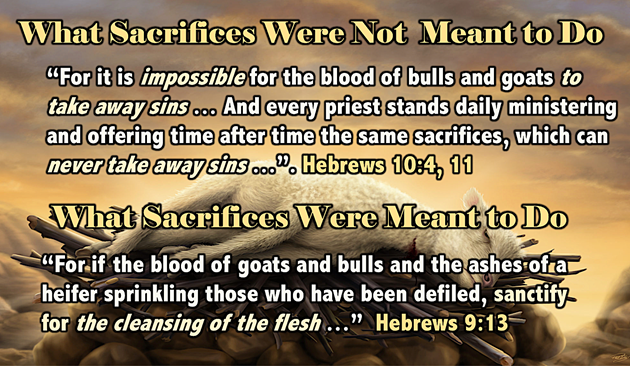
The Meaning of “Atonement”
The basis of the Atonement View of Millennial sacrifices is the proper understanding of the word “atonement.” The verb appears in ritual contexts in the Piel stem which intensifies the action described or indicates causation. Since Ezekiel states that these offerings “make atonement,” the offerings actually did something. Therefore, what did atonement accomplish in Ezekiel and what will be its function in the Millennial economy?
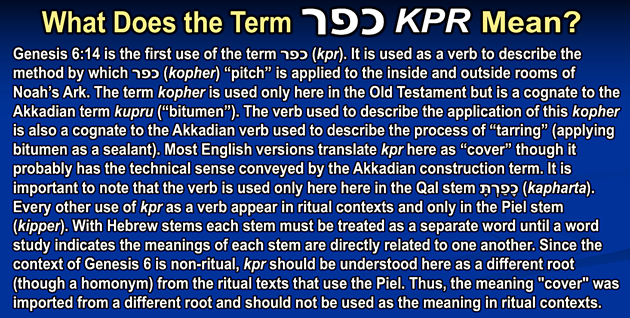
Two studies of this word in the Old Testament, one with a concentration on its meaning in the Book of Leviticus,[62] and the other paying special attention to Ezekiel’s usage in chapters 40-48,[63] have offered a re-evaluation of its meaning in the context of a theocratic government. Their research has determined that the understanding of the Hebrew term for atonement, kipper, should be “to purify” or “cleanse,” based on the Akkadian cognate kuppuru, rather than the traditionally understood meaning of “to cover” borrowed from the cognate Arabic kapara or the ransom/propitiation view, based on the noun form kopper, which sees “atonement” as the “averting of divine wrath by the payment of a ransom.”[64] The idea of “cover over,” that has been popularly expressed in Christian books treating this subject for over a century, is that the blood “covered up” or “hid” the offenses from the sight of God so that in not seeing them He would not exact punishment for them. In this light the Mercy Seat of the Ark of the Covenant, called in Hebrew the kipporet, from kipper (“to atone”), has been explained as a box containing objects connected with Israel’s past sins which needed to be hidden from the Presence of the Lord enthroned above the cherubim on either side of the Mercy Seat.[65] The concepts of divine wrath and payment are certainly present in the act of “atonement,” but the explanation of propitiation/ransom does not take into account the wider range of usage in Leviticus nor the syntax and synonyms of the verb kipper. For example, in Leviticus, where the meaning of the term is established, God never appears as the direct object of “atonement,” but only objects and persons (indirectly) that have become ceremonially impure. Therefore, contrary to the idea of propitiation and ransom, the act of “atonement” is not exercised on God nor something that directly affects Him. This is consistent with the purpose of “atonement” as it is used in Ezekiel 40-48. As Hebrew University professor Moshe Greenberg, author of a scholarly three-volume commentary on Ezekiel, explains:
This is done by purgation and whole offerings whose function is to kipper (purge), hitte’ (decontaminate), and tihher (purify), the altar so as to make it fit for the regular worship (43:20, 22, 26). These rites have … to do with … the very ancient idea that all pollutions … contaminated the sanctuary.

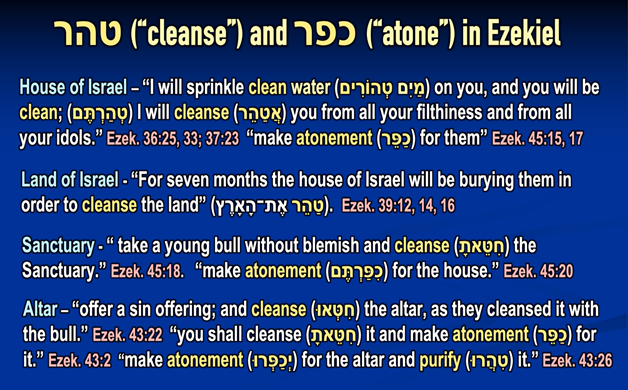
Therefore, according to this view, what sacrifice accomplished was the removal of ritual impurity in order to restore the ability of worshippers to approach God. This concept understands that ritual violations (such as those specified in Leviticus), result in a ceremonial condition of uncleanness which not only interrupts and restricts the worship of the one who has committed an offense, but by its contagious nature is able to contaminate other people and objects, disrupting the required service of God. Thomas J. Crawford stated that just as this contamination could be imparted to everyone, so it could be purged by anyone who followed the ritual requirements for atonement:
It seems very evident that the Mosaic sacrifices have a certain real efficacy ascribed to them in the Old Testament. Nor is there a word said to indicate that this efficacy depended either on the inward dispositions of the worshipers, or on any prefigurative reference, whether understood or not, which their offerings may have had to the great sacrifice of the cross. So far as we can learn from the terms of the Mosaic statutes, the sacrifices seem to have been of unfailing benefit in all cases in which they were punctually and exactly offered. Their efficacy, such as it was, belonged to the ex opere operato.[66]
Failing to seek atonement, the entire Nation would suffer uncleanness which would threaten the Temple itself with defilement. This would create a situation such as that reported by Ezekiel in chapters 8-11 that resulted in the departure of the Shekinah (Divine Presence) from the Temple. If this occurred, the promise of restoration would be reversed and the people would again suffer exile. However, the promise of the Millennial restoration is that this reversal will never again occur (Isaiah 2:4; 51:22; Jeremiah 31:34, 40; Ezekiel 36:25-30; 37:23-28; Daniel 2:44; Joel 3:17, 20; Zechariah 8:11-15). Therefore, to protect the holiness of the Divine Presence and prevent problems associated with the human condition (unholiness) the safeguards of the New Covenant include both the external requirements necessary to create a sanctified status (Jeremiah 33:18; Ezekiel 44:23-25) and the internal provision of a new heart necessary to maintain it (Jeremiah 31:33; Ezekiel 36:26-27; Zechariah 13:1).
In this light it is necessary to remember three facts about life in the Millennial Kingdom. First, the Presence of God will be literally dwelling in the midst of the people. As in the time of the Tabernacle and First Temple God’s manifest Glory will be on earth (Ezekiel 43:1-7), but unlike those days the Glorified Christ will be resident in the Temple (Zechariah 2:10-1114:9), extending an unparalleled degree of sanctity to the entire city of Jerusalem (Isaiah 4:5; Jeremiah 3:17; Zechariah 2:5; 14:11, 20-21) and requiring sanctified conditions for the entire earth (Isaiah 11:9; Habakkuk 2:14; Zechariah 14:9, 16-18). Second, the unglorified human population will be capable of incurring ritual defilement and polluting the earthly Sanctuary. Even though those who initially enter the Millennial Kingdom are all regenerate (Jews: Ezekiel 20:33-38; Gentiles: Matthew 25:31-46), they are still mortal beings who intentionally or unintentionally can violate ceremonial standards. Furthermore, they will produce children who may or may not become spiritually regenerate and receive a new heart (see Revelation 20:7-8), and therefore lack the inward restraint of sin. Third, the Millennial population will be under the New Covenant will be regarded as a holy Nation just as they were under the Mosaic Covenant. Whether or not this is individually so, it was and will be corporately required. While the understanding of a penal substitution and faith in God as Savior should have resulted in personal spiritual salvation for the individual Israelite under the Mosaic system, and faith based on the universal and undeniable knowledge (Jeremiah 31:34) of the past work of the now resident and ruling resurrected and glorified Messiah (Jeremiah 33:15-16) should save in the future, in both Jewish ages the Nation (and in the future the nations) must maintain a status of ceremonial purity. As argued above, this kind of sacrificial “atonement” is not for salvation nor for inward sanctification, but to preserve outward corporate “sanctification” (or ceremonial purification) so that a holy God to remain in the midst of an unholy people. Therefore, since every member of this theocratic kingdom will be required to conform to the ceremonial requirements, the sacrificial system will be necessary to sustain corporate sanctity.
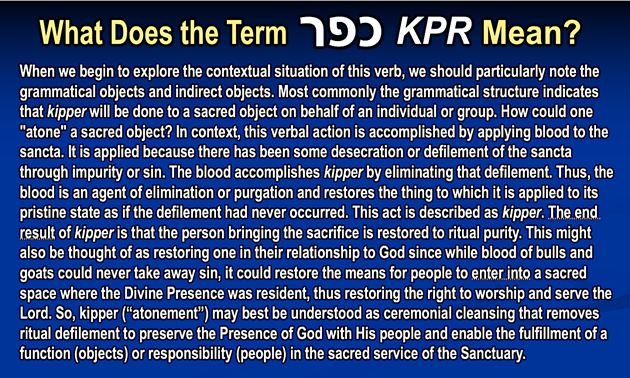
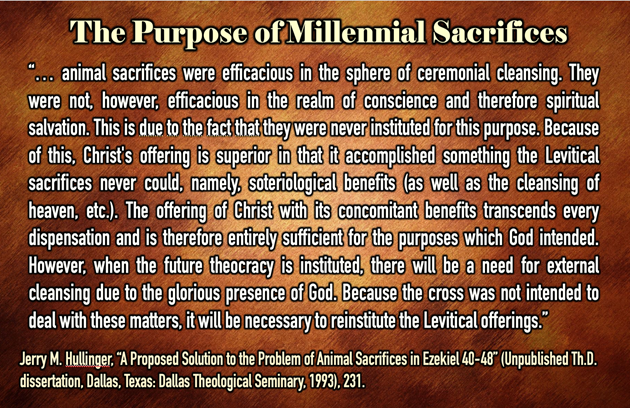
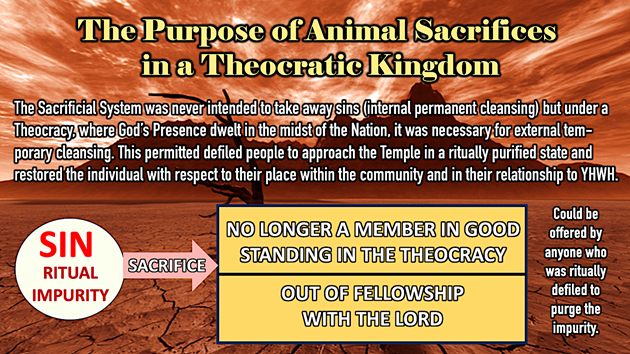
Millennial Sacrifices and Christ’s Sacrifice
If the foregoing discussion has been understood then it should be apparent that the act of offering sacrifices after the sacrifice of Christ does not conflict nor present a contradiction. While the sacrificial system was effective it was not expiatory. In the words of Hebrews, it was effective for temporary ritual restoration, the “cleansing of the flesh” (Hebrews 9:13; compare 9:10), but it could not permanently expiate guilt by “taking away sin” (Hebrews 10:4) or “cleansing the conscience” (Hebrews 9:9, 14). The ceremonial system was never meant to have this purpose, but to serve in keeping a holy Nation (Exodus 19:6) outwardly conformed to a holy status (Leviticus 11:44-45; 19:2; 20:7). This will be even more necessary when the glorified Lord returns to earth and establishes the Jewish People as a Nation of priests in the Millennial Kingdom (Isaiah 61:6; compare 66:21). Hullinger summarizes these points:
The author does say that animal sacrifices were efficacious in the sphere of ceremonial cleansing. They were not, however, efficacious in the realm of conscience and therefore spiritual salvation. This is due to the fact that they were never instituted for this purpose. Because of this, Christ's offering is superior in that it accomplished something the Levitical sacrifices never could, namely, soteriological benefits (as well as the cleansing of heaven, etc.). The offering of Christ with its concomitant benefits transcends every dispensation, and is therefore entirely sufficient for the purposes which God intended. However, when the future theocracy is instituted, there will be a need for external cleansing due to the glorious presence of God. Because the cross was not intended to deal with these matters, it will be necessary to reinstitute the Levitical offerings.[67]
However, the penal substitution that was inherent in the nature of sacrifice and demanded an inward identification with sin and its punishment looked forward to an ultimate realization of this in God the Savior. Since this was only possible through substitution, the Savior offered Himself in place of guilty sinners to both expiate (remove guilt of sin) and propitiate (appease the righteous wrath of God against sin). Therefore, the outward and earthly character of the ceremonial sacrifices and the internal and spiritual character of Christ’s sacrifice are of two different kinds, operated in two different spheres, and were for two different purposes. Under the present administration of grace in which Christ is absent from the earth and our approach is in the heavenly realm, sanctification is possible under the spiritual provision of the New Covenant (the Holy Spirit, the new heart). However, under the coming administration of the kingdom in which Christ will be present on the earth and the approach will be at the Temple in Jerusalem, outward corporate “sanctification” (or ceremonial purification) will be necessary as well as inward personal sanctification under the full terms of the New Covenant. This is obvious in the instructions for those Gentile nations who have been commanded to observe Succot in the millennial Jerusalem. At this time conditions within the city are so holy that even common cooking pots will be as ceremonially pure as the bowls before the Temple’s altar (Zech. 14:16-20). Under divine command these worshippers are to take these cooking pots and use them to boil the sacrifices they will offer God in the Millennial Temple (Zech. 14:21; cf. Isa. 66:20).
Those offering sacrifices in the Millennial Temple are filled with the Holy Spirit (Ezek. 36:27; 37:14). This understanding was apparently that of all of the Apostles. Luke reports that immediately after Christ’s ascension and receiving a blessing from Him “they returned to Jerusalem with great joy and were continually in the Temple, praising God” (Lk. 24:50). “Praising God in the Temple” involved offering sacrifice. This should be read in concert with Luke’s further report that during this time – and after being “filled with the Holy Spirit” (Acts 2:4) – Peter and John went to the Temple at the ninth hour (3 pm) “to pray,” which according to Jewish sources involved the offering of a lamb for sacrifice (Ex. 29:39; Num. 28:4; Mishnah, Tamid 4:1; Josephus, Antiquities of the Jews 14.4.3 (14:65); Philo Special Laws I, XXXV (169). Christ and His Apostles’ also met at this time which culminated 40 days of Christ’s teaching them “concerning the kingdom of God” (Acts 1:3), which they understood was related to “restoring the kingdom to Israel” (vs. 6).
This also seems to have been the understanding of the Apostle Paul who interrupted his missionary work among the Gentiles to return to Jerusalem in ritual compliance to attend the Feast of Pentecost (Acts 20:16) and with other four men who were “Jews who had believed,” Acts 21:20) underwent ritual purification and went to the Temple to have sacrifices offered for them (Acts 21:26). Moreover, this event took place in the latter part of Paul’s ministry well after he had clearly defined and defended the substitutionary sacrifice of Christ in the context of Judaism (cf. Romans, Galatians). As Hullinger notes: “Paul understood the differing purposes between animal sacrifice under the old economy and the death of Christ in the New Testament era. It is unthinkable that Paul would have offered animal sacrifice if this had not been the case.”[68] At the end of his life, when he was on trial for his faith, he stated he went in the Temple “to present offerings” (Acts 24:17) and that he had “committed no offense either against the Law of the Jews or against the Temple” (Acts 25:8). If Paul had thought that the continuance of the sacrificial system within Judaism was a theological violation in opposition to the final sacrifice of Christ, he could not have made this declaration. He understood that there are two types of atonement (temporary/external and permanent/internal), Heb. 9:13-14, and that what Christ’s sacrifice accomplished in the heavenly realm was different from what was accomplished through the earthly sacrificial system. This point is often missed by Classical Dispensationalist: “a pattern of sacrifice informs the NT reader that Christ accomplished for believers in the heavenly court of justice what the blood of bulls and goats could accomplish only in the civil courts of an earthly theocracy.”[69] However, the difference is not a matter of place but of purpose.
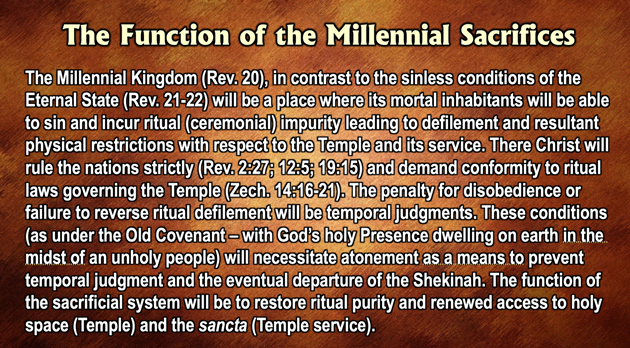
In the same way, there is a heavenly (internal and permanent) atonement and an earthly (outward and temporal) that is necessary to sanctify believers on earth (Hebrews 9:13-14; cf. 1 John 1:7-9 (note "cleanses," vs. 7 is present tense - He keeps on doing this throughout our lives on earth). Jesus has a very present high priestly role in the Heavenly Temple based on his atoning sacrifice and a future role within the earthly Millennial Temple after His return.
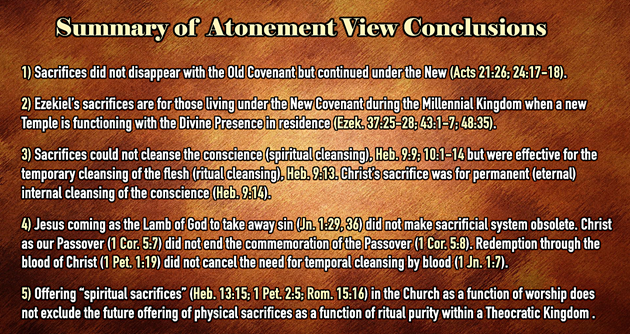
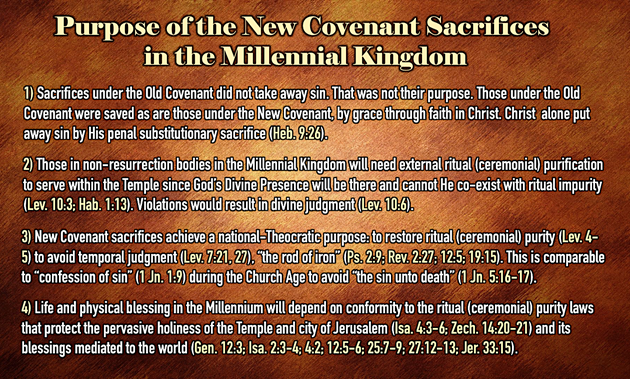
In conclusion, Charles Ryrie adds some practical purposes of the atonement view:
Thus, millennial sacrifices concern (1) payment, (2) proclamation, and (3) proof. They will render payment for sins committed against the government to effect theocratic forgiveness. They will proclaim the once-for-all death of Christ on the cross - a proclamation that will be frequent and clear, for the people will have available the presence of the Savior and the entire Bible to read. And they will offer proof of changed lives by those who will bring chem out of love and a pure heart. These are all worthy purposes and in no way backward steps in the progressive revelation of the glory of God.[70]
The Consequences of Inconsistent Dispensational Interpretation
Older Classical Dispensationalists often struggled with the literal interpretation of Old Testament passages concerning Israel’s nation restoration in relation to the Tabernacle and Temple and its priestly service. They tended to view these ritual institutions as spiritually fulfilled in Christ and His Church, despite their acknowledgement of the dispensational sine qua non that there are distinctive fulfillments for Israel and the Church. For example, A.R. Fausset in his Commentary on Ezekiel (1870) wrote:
There are things in it so improbable physically as to preclude a purely literal interpretation … The ideal temple exhibits ... the essential character of the worship of Messiah as it shall be when He shall exercise sway in Jerusalem among His own people, the Jews, and thence to the ends of the earth … Though the writer believes in an earthly millennium, he does not see its temple as purely literal.[71]
Older Classical Dispensationalists maintained that God had an earthly people (Israel/Jewish People) and a heavenly people (the Church, which contained neither Jews nor Gentiles, but only Christians). This distinction allowed them to have a literal future for National Israel following the New Creation Model and to have a heavenly (spiritual) future for the Church following the Spiritual Vision Model. This also allowed for typology and spiritualization to explain how Old Testament restoration passages could be understood and applied to the Church. While these were often applications rather than interpretations, they did not make this distinction and thereby influenced their generation of biblical students to follow suit. How many books from these teachers were written on the spiritual symbolism of the Tabernacle and its furniture even though neither the Old Testament nor the New Testament offers any guideline for doing such (cf. Heb. 9:2-5). For an example, of how the older Classical Dispensationalists spiritualized Ezekiel 40-48 consider J. Sidlow Baxter who tells us that "the main meanings of the striking symbols are clear ... The various cube measurements symbolize their divine perfection. In the description of the sacrificial ritual we see the absolute purity of the final worship."[72] In similar manner Harry Ironside (followed by Arno C. Gaebelein in his commentary on Ezekiel) employed this same spiritualizing tendency in his explanation of the river that flowed from within the Millennial Temple toward the Dead Sea (Ezekiel 47:1-12):
Ezekiel's guide measured a thousand cubits, that is, fifteen hundred feet, and he caused the prophet to enter into the waters: they were up to his ankles. May this not suggest the very beginning of a life of fellowship with God? 'If we live in the Spirit let us also walk in the Spirit' (Gal 5:25). The feet were in the river and the waters covered them, but the guide measured another thousand cubits and caused Ezekiel to pass through the waters, and they were up to his knees. Who will think it fanciful if we say that the waters up to the knees suggest praying in the Holy Spirit? But the guide measured another thousand and caused the prophet to pass through the waters, and now they were up to his loins, suggesting the complete control of every fleshly lust in the power of the Spirit of God. He measured another thousand, and that which had begun as a small stream was a river so that Ezekiel could not pass through, for the waters were risen, waters to swim in. Surely this is to live in the fullness of the Spirit to which every child of God should aspire.[73]
John C. Whitcomb speaks decisively concerning this inconsistency by Dispensationalists in literal interpretation:
In my opinion, such an exposition of Holy Scripture is not only fanciful but dangerous, causing the student to wonder whether each expositor is not, after all, a guide unto himself, the blind leading the blind. If the commentator rejects the literal interpretation of the passage and fails to find support elsewhere in Scripture for a consistent figurative or symbolic interpretation, he should confess his ignorance, leave the passage alone, and go elsewhere. For many centuries the Church has been subjected to various spiritualizing interpretations of Old and New Testament prophecies concerning the Second Coming of Christ. It is our prayer that God will raise up many faithful students of His Word in these last days who will search the prophetic Scriptures in the belief that God actually means what He says.[74]
To be sure, the critics of what they called “dispensational literalism” also recognized their inconsistency in the interpretation of Ezekiel 40-48 and were keen to point it out. Consider the admonition of Reformed scholar Anthony Hoekma against a statement in The New Scofield Reference Bible (New York: Oxford University Press, 1967), p. 888, n. 1 that spiritualizes the sacrifices within a literal Temple: “We can hardly spiritualize the sacrifices and then literalize the Temple.”[75]
In my opinion, the failure to maintain a consistent literal interpretation in Old Testament prophetic texts has led countless biblical students who started with a proper hermeneutic to abandon it for more consistent ones, such as the spiritualizing method of Reform Theology. Below are a list of the pitfalls and problems resulting from inconsistent interpretation:
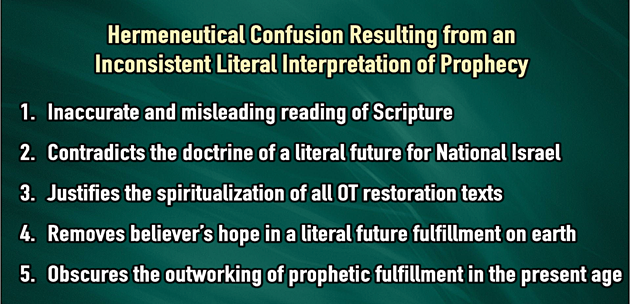
Recognizing the problems of inconsistent interpretation, especially as Dispensationalists implement the requirements of the New Creation Model in their interpretation of Old Testament restoration texts, will hopefully encourage a new generation of biblical students to strive for hermeneutical consistency while maintaining the sine qua non of Dispensationalism. To those who will continue to follow such a hermeneutic, may they find encouragement in conclude the words of John C. Whitcomb:
Those who have discovered that the key to interpreting God's Word properly is to understand it in a normal/literal way, will also discover that Ezekiel 40-48 is not a burden to the Bible student, but a delight. What joy God brings to the heart of the believer when he realizes, perhaps for the first time, that God did not give us any portion of His Word to confuse us, but rather to enlighten us. God really does mean what He says![76]
Endnotes
[1]S. Fisch, Ezekiel. Soncino Books of the Bible. Ed. A. Cohen (London: The Soncino Press, 1973), 265.
[2] Charles Lee Feinberg, The Prophecy of Ezekiel (Chicago: Moody Press, 1967), 233.
[3] Andrea L. Robinson, Temple of Presence: The Christological Fulfillment of Ezekiel 40–48 in Revelation 21:1—22:5 (Wipf & Stock, 2019). In her parallels between Revelation 21-22 and Ezekiel 40-48 she argues from comparative apocalyptic works from the Second Temple period and intertextual research that the tenor of thought in John’s time influenced him to utilize Ezekiel's imagery to portray Jesus Christ as the eschatological temple where heaven and earth unite. She argues based on this cultural preunderstanding that John’s original Jewish-Christian audience would have viewed the Temple’s replacement in Revelation as a fulfillment in Christ and His Church.
[4] George Athus, Bridging the Testaments: The History and Theology of God’s People in the Second Temple Period (Grand Rapids: Zondervan Academic, 2023), 388-89.
[5] Jerry M. Hullinger, “A Proposed Solution to the Problem of Animal Sacrifices in Ezekiel 40-48,” 206-207.
[6]Mark Karlberg, “The Significance of Israel in Biblical Typology,” Journal of the Evangelical Theological Society 31:3 (September 1988), 268.
[7] For a full presentation of this model see Michael J. Vlach, The New Creation Model: A Paradigm for Discovering God’s Creation Purposes from Creation to New Creation (Cary, NC: Theological Studies Press, 2023) and J. Richard Middleton, A New Heavens and a New Earth: Reclaiming Biblical Eschatology (Grand Rapids, MI: Baker Academic, 2014). See also, Craig Blaising, “Premillennialism,” Three Views on the Millennium and Beyond (Zondervan, 1999).
[8] For a detailed study of this concept see Randall Price, “Theocratic Theodicy: An Exegetical and Theological Study of Ezekiel 36:18-36” (Th.M. Thesis, Dallas Theological Seminary, 1981).
[9] Hays, Jeremiah and Lamentations, 232–33.
[10] Robert B. Chisholm Jr., Handbook on the Prophets: Isaiah, Jeremiah, Lamentations, Ezekiel, Daniel, Minor Prophets (Grand Rapids, MI: Baker Academic, 2002), 285–286.
[11] Erecting an altar was all that was necessary to resume the sacrificial system (Ezra 3:2-3) and the exilic community stopped after laying the Temple’s foundations (Ezra 3:7-13) for fear of “the peoples of the lands” (Ezra 3:3b; 4:4; 5:3-9) and to build their own houses (Hag. 1:1-4). The actual rebuilding of the Temple structure did not resume for another 15 years and only after Darius paid for the construction (Ezra 6:8-15) and the prophets provoked the work through their warning of divine discipline (Hag. 1:6, 9-11; 2:15-19). The fact that Sheshbazzar (Zerubbabel) had brought back from Babylon 5,400 of the Temple vessels only adds to the indictment of ritual neglect (Ezra 1:7-11) which was compounded by ritual abuse (Mal. 1:6-2:9) and covenant violations (Neh. 9:1-4; 10:30-31; 13:4-31; Mal. 2:10-17; 3:5-13).
[12] Yigael Yadin, The Temple Scroll: The Hidden Law of the Dead Sea Sect (New York: Random House, 1985), 113 (see further the official publication: The Temple Scroll. Edited by Y. Yadin. 3 vols. Jerusalem (Israel Exploration Society, 1977-83).
[13] The Samaritan temple complex was expanded during the Hellenistic period (ca 200 BC), and functioned until the Maccabean ruler John Hyrcanus destroyed it in 110 BC. Only the site was revered thereafter (Jn. 4).
[14] Josephus, Antiquities 11:302-303, 306-312 recorded the story of Menashe, a Jerusalem high priest who flouted Jewish law by marrying the Samaritan Nikaso, daughter of Sanballat. He demanded Menashe leave the Jerusalem (First) Temple and he built for him an exact replica of it on Mt. Gerazim where he would preside as High Priest.
[15] George Athas, Bridging the Testaments: The History and Theology of God’s People in the Second Temple Period (Grand Rapids: Zondervan Academic, 2023), 62. This author also adds in a footnote (36) that this may explain the use of older architectural features discovered in the archeological excavation of the Samaritan sanctuary (for which see Ephraim Stern and Yizthak Magen, “Archaeological Evidence for the First Stage of the Samaritan Temple on Mount Gerizim”, Israel Exploration Journal 52:1 (2002), 49-57 and Yitzhak Magen, “The Temple of YHWH at Mt. Gerizim” (Hebrew) Eretz-Israel: Archaeological, Historical and Geographical Studies Ephraim Stern Volume (2009): 277-297.
[16] Apparently the renegade priest Menashe who designed the Samaritan temple used this knowledge polemically.
[17]Cf. Jon Levenson, Theology of the Program of Restoration of Ezekiel 40-48 (Missoula, Montana: Scholars Press, 1976), p. 112 notes: "The immensely detailed vision of the restored community in Ezekiel 40-48 comes as no shock to the sensitive reader of chaps. 1-39."
[18]Steven S. Tuell, The Law of the Temple in Ezekiel 40-48. Harvard Semitic Monographs 49. Edited by Frank Moore Cross (Atlanta: Scholars Press, 1992), 175.
[19]Rav Dr. Joseph Breuer, The Book of Yechezkel: Translation and Commentary (New York - Jerusalem: Philipp Feldheim, Inc., 1993), 353.
[20]For the support of this translation rather than that which appears in most English versions (“with them”) see Moshe Greenberg, Ezekiel 21-37: A New Translation with Introduction and Commentary. The Anchor Bible (New York: Doubleday, 1997), 757-758.
[21]For additional confirmation of this connection see Mark F. Rooker, “Evidence from Ezekiel,” A Case for Premillennialism: A New Concensus, eds. Donald K. Campbell and Jeffrey L. Townsend (Chicago: Moody Press, 1992), 128-129.
[22] Moshe Greenberg, “The Design and Themes of Ezekiel’s Program of Restoration,” Interpretation 38 (April 1984), 182.
[23] Merrill F. Unger, Great Neglected Bible Prophecies (Chicago: Scripture Press, 1955), 93.
[24] For additional details on the Millennial Jerusalem see Randall Price, Jerusalem in Prophecy: God’s Stage for the Final Drama. Revised & Updated edition (NJ: Friends of Israel, 2020).
[25] Corrine L. Carvalho, The Book of Ezekiel: Question by Question (New York: Paulist Press, 2010), 160.
[26]Daniel I. Block, The Book of Ezekiel, Chapters 25-48, The New International Commentary on the Old Testament (Grand Rapids: Wm. B. Eerdmans Publishing Co., 1998), 505.
[27] For these details as well as pictures of the model see John W. Schmidtt and J. Carl Laney, Messiah’s Coming Temple: Ezekiel’s Prophetic Vision of the Future Temple (Grand Rapids: Kregel Publications,1997).
[28]See Paul Ellingworth, The Epistle to the Hebrews: A Commentary on the Greek Text. The New International Greek Testament Commentary (Grand Rapids: Wm. B. Eerdmans Publishing Co., 1993), 437-442 lists as least seven different points for debate along with the pertinent literature where such variant interpretations may be found.
[29]Jerry M. Hullinger, “A Proposed Solution to the Problem of Animal Sacrifices in Ezekiel 40-48” (Th.D. dissertation, Dallas Theological Seminary, 1993), 188-189.
[30]John C. Whitcomb, “The Millennial Temple of Ezekiel 40-48” (Unpublished Paper, no date), 1-2.
[31]Steven S. Tuell, The Law of the Temple in Ezekiel 40-48, 13-14.
[32]Jon Levenson, Theology of the Program of Restoration of Ezekiel 40-48, Harvard Semitic Monographs 10 (Missoula: Scholars Press, 1976), 37-53.
[33]As cited by Rabbi Shalom Dov Steinberg, The Third Beis HaMikdash. Translated by Rabbi Moshe Leib Miller (Jerusalem: Moznaim Publications, 1993).
[34] For more details see my Secrets of the Dead Sea Scrolls (Eugene, Oregon: Harvest House Publishers, 1996), 110-111, 235-263.
[35] Oswald T, Allis, Prophecy and the Church (Philadelphia: Presbyterian and Reformed Publishing Co., 1947), 246; Edmund P. Clowney, "The Final Temple," WTJ 35 (Winter 1973): 176-77, 189 and passim.
[36] Keith A. Mathison, Dispensationalism: Rightly Dividing the People of God? (Phillipsburg, NJ: P&R Publishing, 1995), 7-8.
[37] Jesus, not Paul, deserves this honor. Christians think of “founding” in the sense that the Church, a unique organism consisting of Jew and Gentile in equal relationship to Messiah by faith (Ephesians 2:11-22), came into existence (Acts 1:4-5, 8; 2:1-4) as Jesus predicted (Matthew 16:18), although it had never before been previously revealed in the Old Testament (Romans 16:25-26; Ephesians 3:3-6). In another sense, Christianity continued the faith of the Old Testament saints, and as such, can be traced back to the beginning of the history of Redemption (Genesis 3:15).
[38]Erich Sauer, From Eternity to Eternity (Grand Rapids: William B. Eerdmans Publishing Co., 1954), 181.
[39] Robert B. Chisholm Jr., Handbook on the Prophets: Isaiah, Jeremiah, Lamentations, Ezekiel, Daniel, Minor Prophets (Grand Rapids, MI: Baker Academic, 2002), 286.
[40]Ibid, 6.
[41]Clive A. Thompson, “The Necessity of Blood Sacrifices in Ezekiel’s Temple,” Bibliotheca Sacra 123:491 (July-September, 1966), 238.
[42] John C. Whitcomb, “The Millennial Temple of Ezekiel 40-48 (An Exercise in Literal Interpretation),” 16-17, accessed at: http://middletownbiblechurch.org/proph/templemi.htm
[43]Matthew has “My Father’s Kingdom,” Mark has “in the Kingdom of God,” while Luke reads “until the Kingdom of God comes.” Each of these reflect a slightly different aspect of the Millennial Kingdom, but together relate to the same eschatological age when Jesus has returned.
[44]Some have suggested that what is here is the messianic banquet of Isaiah 25:6-9, however, this is unnecessary since Passover is the context of Jesus’ promise and Ezekiel 45:21 states a Passover will be celebrated regularly in the Kingdom.
[45]The Sages held that Adam offered sacrifices to God, although this is not stated in the Scriptures (Shabbat 28b, Avoda Zara 8a, Chulin 60a, Midrash, Tehillim 39).
[46]For further explication of these points see John C. Whitcomb, “Christ’s Atonement and Animal Sacrifices in Israel,” Grace Theological Journal 6:2 (1985), 202-208.
[47]See John W. Schmitt and Carl L. Laney, Messiah’s Coming Temple: Ezekiel’s Prophetic Vision of the Future Temple (Grand Rapids: Kregel Publications, 1997), pp. 115-116, 118. John Schmitt also suggests that the altar facing the direction of the Messiah in the Temple explains why the Hebrew word ariel (“Lion of God”) is uniquely used of it. However, it is not certain that this should be the translation of ariel here. In addition, three different words for “altar” appear in this section. Either the types of altars or something about their particular descriptions may be intended in the different translations.
[48]The deviations in sacrificial ritual are among the more than 20 differences between Ezekiel and the Torah that forced the prophecy of chapters 40-48 to either be spiritualized or interpreted for the messianic age when Elijah the Prophet would come and resolve all the difficulties.
[49] Charles H. Dyer, "Ezekiel," The Bible Knowledge Commentary: Old Testament, eds., John F Walvoord and Roy B. Zuck (Wheaton: Victor, 1985), 1303-4.
[50] Interview with John F. Walvoord, San Marcos, Texas, September 20, 1998.
[51]See Arno C. Gaebelein, The Prophet Ezekiel: An Analytical Exposition (New Jersey: Loizeaux Brothers, 1972), 312-313.
[52]For a defense of this purpose of the memorial sacrifices see ibid, pp. 239-248.
[53]Charles Lee Feinberg, The Prophecy of Ezekiel: The Glory of the Lord (Chicago: Moody Press, 1969), 254.
[54] Charles C. Ryrie, “Why Sacrifices in the Millennium?” The Emmaus Journal 11:2 (2002), 301.
[55]E.P. Sanders, The Historical Figure of Jesus (New York: The Penguin Press, 1993), 262.
[56]Joshua Berman, The Temple: Its Symbolism and Meaning Then and Now (New Jersey: Jason Aronson, Inc., 1995), 115.
[57]Nachmanides, Commentary on the Torah, Leviticus 1:9. Trans. Charles B. Chavel (New York: Shilo Publishing House, 1974) as cited by Berman, ibid., p.119.
[58]Joshua Berman, op. cit., p. 125.
[59]For the arguments in favor of this suggestion see Rabbi David Zvi Hoffman, Sefer Vayikra [“Book of Leviticus”]. Trans. Zvi Har Shefer and Aharon Leiberman (Jerusalem: Mosad Harav Kook, 1971-72), 1:150.
[60]See Jacob Milgrom, “Sin Offering or Purgation Offering?,” Vetus Testamentum 21 (1971): 238, and “Israel’s Sanctuary: The Priestly Picture of Dorian Gray,” Revue Biblique 83 (1976): 391.
[61]See Joshua Berman, The Temple: Its Symbolism Then and Now (New Jersey: Jason Aronson, Inc., 1995), 121.
[62]See Richard E. Averbeck, “An Exegetical Study of Leviticus 1:4 With a Discussion of the Nature of Old Testament Atonement” (Unpublished M.Div. thesis: Winona Lake, Indiana: Grace Theological Seminary, 1977).
[63]Jerry M. Hullinger, “A Proposed Solution to the Problem of Animal Sacrifices in Ezekiel 40-48” (Unpublished Th.D. dissertation, Dallas, Texas: Dallas Theological Seminary, 1993).
[64]For a discussion of the lexical issues that determine this preference see Hullinger, ibid., pp. 39-56.
[65]For my own presentation of this popular view see my In Search of Temple Treasures: The Lost Ark and the Last Days (Eugene, Oregon: Harvest House Publishers, 1994), pp. 54-55.
[66]J. Crawford, The Doctrine of Holy Scripture Respecting the Atonement [1871; reprint ed. (Grand Rapids, Baker, 1954], 249.
[67] Jerry M. Hullinger, “A Proposed Solution to the Problem of Animal Sacrifices in Ezekiel 40-48” (Unpublished Th.D. dissertation, Dallas, Texas: Dallas Theological Seminary, 1993), 231.
[68] Hullinger, “A Proposed Solution to the Problem of Animal Sacrifices in Ezekiel 40-48,” 230-32, n. 198.
[69] Mark Snoeberger, “Traditional Dispensationalism” in Covenantal and Dispensational Theologies: Four Views on the Continuity of Scripture. Eds. Brent E. Parker and Richard J. Lucas (Downers Grove: IVP Academic, 2022), 159.
[70] Charles C. Ryrie, Why the Millennial Sacrifices,” The Emmaus Journal 11:2 (2002): 310.
[71] A. R. Fausset, "The Book of the Prophet Ezekiel," A Commentary Critical, Experimental and Practical on the Old and New Testaments, eds. Robert Jamieson, A. R, Fausset and David Brown 1864-70; reprint ed. (Grand Rapids: Eerdmans, 1967), 4:356.
[72] J. Sidlow Baxter, Explore the Book (Grand Rapids: Academie Books, 1964), 34.
[73] Harry Ironside, Ezekiel the Prophet (Loizeaux Brothers, 1949), 327,328,
[74] John C. Whitcomb, “The Millennial Temple of Ezekiel 40-48 (An Exercise in Literal Interpretation),” 17, accessed at: http://middletownbiblechurch.org/proph/templemi.htm
[75] Anthony Hoekma, The Bible and the Future (Grand Rapids, MI: Wm. B. Eerdmans Pub. Co., 1979), 204.
[76] John C. Whitcomb, “The Millennial Temple of Ezekiel 40-48 (An Exercise in Literal Interpretation),” The Diligent Workman Journal 2:1 (May 1994), 1.